




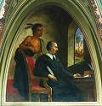





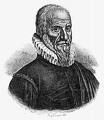
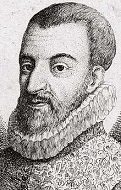
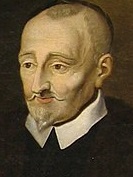

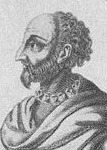

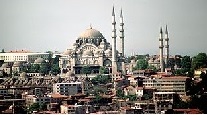
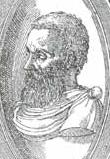



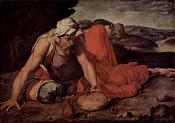
1550 In this decade after five decades of war the Muzo Indians of Columbia, who occupy the emerald-rich area of the E ridge of the Andes Mts. in Columbia are conquered by the Spanish, who force them into slave labor in the mines, causing Colombia to become the world's #1 producer of emeralds. In this half-cent. the European study of classical learning enters a golden age. On Feb. 6 (night) the Battle of Andalien near the Andalien River in Chile is a V for 200 Spanish soldiers under Pedro de Valdivia and 300 Mapochoes auxiliaries under former enemy Michimalonco ("michima" + "lonco" = foreigner + chief) over 20K Mapuche under their chief (toqui) Ainavillo (Aynabillo) (Aillavilu) ("aila" + "filu" = nine snake), who try a surprise night attack on their camp, after which Ainavillo gathers a new 6K-to-60K-man army to attack the new Spanish fort at the Battle of Penco on Mar. 12, losing 4K KIA and 200 taken POW. On Feb. 7 after Cardinal Reginald Pole comes within one vote until he is exposed by his archenemy Cardinal Giovanni Carafa (future Pope Paul IV) as a Spirituali, Gianmaria (Giovanni) Ciocchi del Monte is elected Pope (#221) Julius III (1487-1555) (until Mar. 23, 1555), who likes to sodomize young boys, appointing some of his favorite teenie bonks as cardinals, and going on to bonk his own illegitimate son Bertuccino, causing Cardinal Giovanni della Casa to dedicate his poem In Praise of Sodomy to him - sign me a copy with your brown holy finger? On Feb. 22 Francesco II Gonzaga (b. 1533) dies, and his 2nd son Guglielo (William) I Gonzaga (1538-87) succeeds as duke of Mantua and Montferrat (as Guglielmo X) (until 1587), going on to become a big patron of sacred vocal music, correspond with Palestrina, build the Santa Barbara Church in Mantua, and get the pope to let him create his own rite for Mantua, a first. On Mar. 7 Bavarian duke William IV (b. 1493) dies, and his son Albert (Albrecht) V (1528-79) becomes duke of Bavaria (until Oct. 24, 1579), going on to become a leader of the German Counter-Reformation. So much for the Renaissance, let's start this half-century with blood and fire? Talk about mentally unstable sadists? In Apr. HRE Charles V issues the Eternal Edict Against Heresy of 1550, to be "published forever, once in every six months, in every city and village of the Netherlands", forbidding all meetings in homes for the purpose of religious worship, all reading of the Bible, and all discussion of controversial religious matters; punishment is burning alive, unless one repents, in which case if they are male they are to be beheaded, and if female to be buried alive; death can be escaped only by feeding others to the flames by betraying them; officials showing leniency or mercy are to be removed from office and punished likewise; during Charles V's 40-year rule 50K-100K Netherlanders perish in his cheery little Inquisition. On May 16 after the Treaty of Boulogne (Mar. 24) causes the English to evacuate in Mar., ending the Rough Wooing, Henri II of France formally enters Boulogne, staying three days to admire the fortifications built by the English. On July 7 Chocolate is introduced to Europe? On Aug. 23 Luis de Velasco (1511-64) arrives in New Spain to become its 2nd viceroy, and takes office in Mexico City on Nov. 25 (until 1564). On Oct. 5 the seaport-river city of Concepcion (Concepción) Concepción de la Madre Santísima de la Luz (Conception of the Blessed Mother of Light) (modern-day pop. 292K/1.3M) is founded in the Bio-Bio region of SC Chile by Pedro de la Gasca and Pedro de Valdivia. On Nov. 7 bishop of Holar, Iceland (since 1522) Jon Arason (b. 1484) is killed by Lutherans, becoming the last Roman Catholic bishop of Iceland, uttering the immortal Icelandic soundbyte: "That I know, little Sveinn" before being beheaded after being told "There is a life after this one, sir"; Denmark forces Iceland to disown Roman Catholicism and adopt Lutheranism - welcome back to dancing with the stars? Edward Seymour is released from the Tower. Sir William Cecil, 1st Baron Burghley (Burleigh) (1520-98) becomes English secy. of state (until 1553, then 1558-72). Tsar Ivan IV convokes the Zemski Sobor (Russ. "estates general"), Russia's first Duma (nat. representative assembly), and begins a comprehensive modernization and revision of the Russian law code - what's that stamped on you Cossacks' foreheads, the word Dumas? The epic Valladolid Debate in Spain between pro-slavery Dominican Juan Gines (Ginés) de Sepulveda (Sepúlveda) (1494-1573) and anti-slavery Dominican Bartoleme (Bartolomé) de las Casas (1484-1566), bishop of Chiapas over the plight of the Am. aborigines begins, and after a 5-day speech backed up with armloads of his 40-year research, Casas persuades the king to forbid new expeditions against the Indians and to order that they be treated as humans, although nobody really heeds him and the ban on expeditions expires in 10 years?; meanwhile there is little interest in the New World in Europe, and only in this decade when Spain and England form closer ties does it begin to develop, and until now stupid readers are handed illustrations of Turkish life and don't know the difference, but the development of copper-plate engraving in this half-cent. finally allows accurate reproduction of original drawings, wising them up? The Formula of the Institute, the founding manifesto of the Jesuits changes "propagation of the faith" to "defense and propagation of the faith" as one of its goals, and the battle is on with those *!?*! Protestant heretics - too bad, the cat is out of the bag: only 440 years to the porno-saturated worldwide Internet? Spanish viceroy (since 1546) Father Pedro de la Gasca returns to Spain after pacifying the region and ameliorating the condition of slaves, which pisses-off the Spanish, and New Spain viceroy (since Apr. 17, 1535) Antonio Hurtado de Mendoza quits on Nov. 25, becoming Spanish viceroy #3 of Peru next Sept. 23 (until July 21, 1552), after a long overland trip from Mexico, followed by a boat trip from Panama, soon facing a Spanish revolt led by Francisco Giron (Girón) (-1554) (ends 1554); when Mendoza takes sick and dies on July 21, 1552, the audiencia exercises interim authority to fight the revolt. Don Francisco de Urdinola (Urdiñola) the Elder (1498-), who later strikes it rich with the Bonanza Mine founds San Luis Potosi (Potosí) in C Mexico (modern-day pop. 2.7M) (see 1583); in 1592 gold and silver are discovered, and the town is named in honor of silver-rich Potosi, Bolivia. The first Jesuits reach Brazil. Duke Albrecht of Hohenzollern commissions printer Jan Seklucjan (1510-78), who fled Leipzig for Konigsberg because of his Protestant pubs. to trans. the Bible into Polish, and he goes on to hire Stanislaw Murzynowkski (1528-53) and pub. a Polish Trans. of the New Testament from the Greek in 1553. The Great Vowel Shift in England (begun in 1350) results in Modern English. Scottish queen Mary de Guise visits her daughter Mary Stuart in France, and approves of how she's being brought up a lady. Many of the estates of St. Peter's in Westminster, England are appropriated to pay for repairs to St. Paul's Cathedral, giving an object lesson to the old expression, "Robbing Peter to pay Paul". During this half-cent. Red Bay, across the Strait of Belle Isle from Newfoundland in Canada becomes the largest whaling port in the world (right whales and bowhead whales); Basque whalers from France and Spain work it in 1530-1600. Church records of baptisms, circumcisions, marriages, and burials begin to be kept in the Netherlands. About this time La Pleiade (Pléiade) (named after the 3rd cent. B.C.E. Alexandrian Pleiad) (AKA the Brigade), a group of French Renaissance poets flourishes at the College de Coqueret, led by "Prince of Poets" Pierre de Ronsard (1524-85) (court poet of Charles IX), Joachim du (Du) Bellay (1522-60), and Jean-Antoine de Baif (Baïf) (1532-89), attempting to break with Clement Marot and the grands rhetoriquers and ennoble French by imitating the ancients to make it a worthy language for lit. expression; they are all students of Hellenist Latinist scholar-poet Jean Dorat (Daurat) (Joan Dinemandy) (1508-88). In this decade the Elizabethan Statue of Artificers exempts men over 60 and women over 40 from compulsory military service. In this decade Witches' marks begin to be carved on churches, barns, homes et al. to ward off witches (ends 1750). In this half-cent. court jesters (dwarfs, cripples, etc.) begin to appear in Europe; they often have noble rank? - survivors from all the religious torture looking for sanctuary in clown suits? In this half-cent. codpieces go out of fashion in Europe after flourishing for a cent. - too easy to get caught in all the fires? In this decade Wallpaper is brought from China to Europe. About this time the English call the French arquebus the "caliver" (caliber). In this decade Ivan IV the Terrible begins minting coins showing a knight with a spear (kopje), which become known as Kopeks. Just as it is ending, the word "Renaissance" (Rinascita) is coined in an Italian work by Italian art historian Giorgio Vasari (1511-74). In this half-cent. Spanish writers begin developing the picaresque novel, the Moorish novel (chivalric tales of fighting the Moors), and the pastoral novel (idealized shepherds, stolen from Italy and Portugal); the first Moorish novel is the anon. El Abencerraje. Japanese Ukiyoe (Jap. "pictures of the floating world") Painting begins in this decade. Tales of La Llorona (The Weeping Woman) begin to be told in Mexico City, about Maria, who drowns her children in the river after learning that her hubby left her for a younger woman, then drowns herself, and is refused entry to Heaven until she finds them, causing her to wander Earth forever. Sports: The first written reference to the game of Cricket (Creag) occurs in Edward VI's wardrobe accounts as played by pupils of Royal Grammar School in Guildford. Architecture: Andrea Palladio's Palazzo Thiene in Vicenza (begun 1545) is completed. The Suleymaniye Mosque, the most beautiful mosque in Constantinople is begun, designed by #1 Ottoman architect Mimar Sinan (1489-1588) (finished 1558). About this time a Great Wall is built on the Big Island of Hawaii to create a place of refuge for those breaking kapus, later becoming the site of Pu'uhonua o Honaunau Nat. Historic Park. Inventions: In this decade the Screwdriver and Wrench are invented by Euro gunsmiths and armorers? In this decade Sealing Wax is first used in Europe. Science: Girolamo Cardano (1501-76) of Italy describes the Biconvex Lens in use in a camera obscura. French surgeon Ambroise Pare (Paré) (1510-90) develops the first Ligature to stop bleeding during surgery, and traces phantom pains to the brain. Nonfiction: Thomas Cranmer (1489-1556), A Defence of the True and Catholic Doctrine of the Sacrament of the Body and Blood of Christ. Sigismund von Herberstein (1486-1566), De Natura Fossilium. Robert Estienne (1503-59), Greek New Testament, 3rd Ed.; first to incl. notes documenting differences among the Greek mss. Rabbi Joseph Karo (1488-1575), Shulhan Arukh (1550-9); authoritative handbook on Jewish law. John Knox (1505-72), Doctrine That the Sacrifice of the Mass Is Idolatry; A Summary of the Sacrament of the Lord's Supper. Pedro de Cieza de Leon (1520-54), Journal of Travels; first to give the avocado the Spanish name aguacate, from the Aztec word "ahuacatl" for testicle - no wonder the English prudes changed it to alligator pears? Andreas Osiander (1498-1552), De Lege et Evangelio; De Justificatione; splits with Luther and Calvin with the view that justification by faith is instilled in rather than ascribed to humanity by Christ's divinity, causing a big quarrel in Konigsberg with Philip Melanchton, which spreads to Osiander's backer Duke Albrecht I of Prussia, causing a strain on his reign until Osiander kicks off in 1552, after which the duke is forced to consent to a condemnation of Osiander's teaching. Rhaeticus (1514-74), Trigonometric Tables. Aegidius Tschudi (1505-72), Chronicon Helviticum; the early history of the Swiss Confederation; not pub. until 1734. Giorgio Vasari (1511-74), Lives of the Most Excellent Italian Painters, Sculptors, and Architects, from Cimabue to Our Times; 2nd ed. 1568; written after Cardinal Farnese asks him to assemble a "catalog of artists and their works listed in chronological order" in Rome in 1546; initiates the study of art history in the West, and coins the term "Renaissance" (Rinascita) - the masters are themselves the subject? Otto Wermueller, A Spiritual and Most Precious Pearl; trans. into English by Miles Coverdale. Art: Hans Eworth (1520-74), Sir John Luttrell. Lorenzo Lotto (1480-1556), A Nobleman in His Study. Michelangelo (1475-1564), Deposition from the Cross; designed for his own tomb; The Crucifixion of St. Peter (Pauline Chapel, Vatican) (his last fresco). Frans Verbeeck (1510-70), Portrait of the Jester. Daniele da Volterra (1509-66), The Prophet Elias (1550-60); lounges on the ground with bread. Music: John Marbeck (1510-85), The Booke of Common Praier Noted; the first musical setting of the English liturgy? Plays: Olaus Petrie (1493-1552), Tobia Commedia; first Swedish stage play. Hans Sachs (1494-1576), The Wandering Scholar from Paradise. Poetry: Pierre de Ronsard (1524-85), Odes. Novels: Giovanni Francesco Straparola (1480-1557), Thirteen Facetious Nights (Tredici Piacevoli Notti) (2 vols.) (1550-3); first European collection of fairy tales, containing 75 stories incl. "Beauty and the Beast", and "Puss in Boots", later used by Charles Perrault, William Shakespeare, and Moliere; modelled on Giovanni Boccaccio's "The Decameron", about guests at a 13-night party on Murano Island near Venice, who tell each other stories; Spanish trans. pub. in 1583; placed on the Prohibited Index in 1624. Births: The ultimate My Name is Earl? English noble brain man (the real Shakespeare?) Edward de Vere, 17th Earl of Oxford (d. 1604) on Apr. 12. French Valois king (1560-74) Charles IX (d. 1574) on May 30 in Saint-Germain-en-Laye; son of Henry III and Catherine de' Medici; husband of Elisabeth of Austria. German astronomer Michael Mastlin (Maestlin) (Mästlin) (Möstlin) (Moestlin) (d. 1631) on Sept. 30 in Goppingen; Kepler's first teacher. Swedish king (1604-11) Charles (Karl) IX (d. 1611) on Oct. 4 in Stockholm Castle; youngest son of Gustav I and 2nd wife Margaret Leijonhufvud. Dutch (Flemish) landscape painter Mathys Bril (the Younger) (d. 1584) in Antwerp; brother of Paul Bril (1554-1626). French gen.-statesman Henri de Lorraine, 3rd Duc de Guise (d. 1588); son of Francois de Lorraine, 2nd Duc de Guise (1519-63). English Separatist leader Henry Barrow (Barrowe) (d. 1593) in Norfolk. Ottoman valide sultan (1583-94) Sophia (Sofia) (Sofiyeh) (Safiyeh) ("the Light or Pure One") Baffo (d. 1605) in Corfu; daughter of the Venetian gov. of Corfu; a gorgeous blonde captured in the 1560s by the Turks who becomes the sultan's top harem girl (wife) and rules the Ottoman empire behind the scenes with P-power. Italian "L'Amfiparnasso" madrigal composer (Benedictine monk) Orazio Vecchi (d. 1605) in Modena; studies with Salvatore Essenga. Spanish "The Poetic Exemplar" dramatist-poet Juan de la Cueva de Garoza (d. 1612) (b. 1543?) in Seville. English impresario Philip Henslowe (d. 1616) in Lindfield, Sussex. Irish rebel leader Hugh O'Neill, 2nd Earl of Tyrone (d. 1616) (b. 1540?) in Tyrone; 2nd son of Matthew O'Neill, illegitimate son of Conn O'Neill, 1st earl of Tyrone. Chinese dramatist Tang Xianzu (Hsien-tsu) (d. 1616); author of Peony Pavilion (The Return of the Soul). Scottish mathematician (Protestant) ("Marvellous Merchiston") John Napier (Neper), Laird of Merchiston (d. 1617) in Merchiston (near Edinburgh); educated at St. Andrews U.; inventor of logarithms - stick that slide rule up your what? English Anglican clergyman and Congregationalism (Brownists) founder ("Father of the Pilgrims") Robert Browne (d. 1633) in Tolethorpe Hall, Rutland; educated at Corpus Christi College, Cambrdige U. Deaths: English diplomat Thomas Magnus (b. 1463) on Aug. 18 in Sessay, North Riding of York. Scottish philosopher-historian John Major (b. 1467) on May 1 in St. Andrews. Italian poet Gian Giorgio Trissino (b. 1478) on Dec. 8 in Rome. English noblewoman (mother of Queen Jane Seymour) Margery Wentworth (b. 1478) in Oct. Turkish Shiite composer Pir Sultan Abdal (b. 1480) (executed for pro-Safavid activities) - the Muslim Bob Dylan? Icelandic Roman Catholic bishop (last) Jon Arason (b. 1484) on Nov. 7 in Skalholt (murdered); last words: "That I know, little Sveinn". French madrigal composer Philippe Verdelot (b. 1485). Italian duke Ferdinand of Calabria (b. 1488) on Oct. 20. German Bavarian duke William IV (b. 1493) on Mar. 7. French duke of Guise #1 (1520-58) Claude of Lorraine (b. 1496) on Apr. 12 in Chateau de Joinville, Champagne; the pop. of Joinvile greets him with the cry "Hosannah to the son of David". French cardinal Jean de Lorraine (b. 1498) on May 18 in Neuvy-sur-Lore. Italian artist Niccolo Tribolo (b. 1500). Flemish painter Henri Met de Bles (Civetta) (b. 1510). Italian duke of Mantua (1540-50) Francesco III Gonzaga (b. 1533) on Feb. 22.




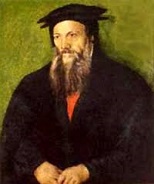

1551 On Feb. 23 Society of Jesus (Jesuits) founder St. Ignatius of Loyola founds the Collegio Romano in Rome as a papal univ., moving it in 1582-4 to Rome's Pigna district under patronage by Pope Gregory XIII; in 1584 it is renamed Gregorian U. On Apr. 1 (Easter Sun.) the English Book of Common Prayer is used for the first time in Ireland at Christ Church Cathedral in Dublin. On May 2 the U. of Lima (Nat. U. of San Marcos) in Lima, Peru is chartered by HRE Charles V, becoming the oldest univ. in the Americas to survive to modern times. After getting pissed-off at Hospitaller attacks on Turkish ships, 12K Ottoman Janissaries on 112 galleys and two galleasses under adm. Dragut (Turgut) Reis (1485-1565) (successor of Khaireddin) and fleet adm. (Kapudan Pasha) Sinan (Sinanuddin Yusuf) Pasha (-1553) attack Venice, followed by Augusta, Sicily, followed by Port Marsa Muscietto, Malta, sieging the citadels of Birgu, Senglea, and Medina, but fail to capture it, instead capturing the sister island of Gozo and taking 5K POWs as slaves; in Aug. they capture Tripoli from the Knights of St. John under cmdr. Gaspare de Villers, who is taken POW along with several knights, who are later released after intervention by French ambassador Gabriel d'Aramon (-1553); after the entire Ottoman fleet abandons Sinan Pasha on the shore and follow Turgut Reis into the Tyrrhenian Sea, causing Sinan to accuse them of mutiny and treason until Sultan Suleiman I orders him to "do whatever Turgut says", Dragut becomes Ottoman gov. of Tripoli (ends 1711) - the idea of a Masonic-run empire in America with its own Marines who can storm the shores of Tripoli takes shape now? On Sept. 22 the Royal and Pontifical U. of Mexico, founded by Luis de Velasco to train young men for the Church (modeled after the U. of Salamanca) is chartered by crown prince Philip on behalf of HRE Charles V; in 1865 anti-clerical Maximilian I of Mexico closes it; it is reopened in 1910, becoming the second oldest Am. univ. to survive to modern times after the U. of Lima, and the most important in the Spanish-speaking world. On Dec. 16 (night) after he develops dreams of glory for Transylvania, deposes John II and his mother Isabella, and recognizes Ferdinand I of Germany as king of a united Hungary, getting a cardinal's hat in return for his services, side-switcher George Martinuzzi (b. 1482) is assassinated by order of his new old pal Ferdinand after being suspected of treason for secret negotiations with his old new pal the Ottoman sultan to cool him down and stop another invasion when he finds about about the deposition; meanwhile Martinuzzi's actions in getting the Hapsburgs to occupy the Ottoman vassal principality of Transylvania renew the war over it (ends 1562); Isabella is given Opelln in Silesia in exchange for Siebenburgen, and Ferdinand I promises to marry John II to his daughter; Pope Julius III excommunicates the assassins, but changes his mind in 1555 - I just wanted to know if you are Tommy the Tourist? The second session of the Council of Trent opens; interrupted 18x, it doesn't finish its work of counter-reformation for 18 years. John Dudley imprisons ex-protector Edward Seymour again in the Tower on trumped-up charges - everything's gonna be okay? John Knox is appointed royal chaplain, going on to work to make the English church more strongly Protestant. The Jews are persecuted in Bavaria. The Ottomans attack Shahrizor Province in the Kurdish mts. of N Iraq (ends 1552). Edward VI appoints merchant Sir Thomas Gresham (1519-79) as his royal factor charged with managing the royal debt abroad, and he goes on to virtually elminate it by stock manipulations on the Antwerp bourse. New pope Julius III relents and grants the duchy of Parma and Piacenza to Ottavio Farnese, but fair-weather friend Ferrante Gonzaga now claims Piacenza and threatens to take Parma too, driving Ottavio into the arms of France, which sends an army and starts a war with Gonzaga, causing the pope to take Parma back and hurl censures at the pesky kid; luckily, it works out okay in the end, and in 1556 Ottavio gets what he wants, becoming duke #2 until his death in 1586. Miles Coverdale becomes bishop of Exter (until 1553). Francis Xavier exits Japan, leaving behind two Jesuits and some Japanese converts; during the remainder of the cent. about 300K Japanese are converted to Roman Catholicism; Xavier then attempts to enter China, but is forbidden; meanwhile missionaries in South Am. do quite nicely. Pope Julius III appoints Giovanni Pierluigi da Palestrina as dir. of music at Cappella Giulia in Rome, followed by the church of St. John Lateran in 1555-61 and the church of Santa Maria Maggiore from 1561-94. Alvar Nunez Cabeza de Vaca is recalled from Paraguay to Spain under arrest and sentenced to banishment in Africa until 1556, when he gets a pardon along with a high judicial office in Seville. The first alehouses and taverns are licensed in England and Wales. French scholar Petrus Ramus (1515-72), who had already pissed-off the Catholic theologians with his criticism of Aristotle in 1543 gets the Cardinal of Lorraine to get him a chair of rhetoric and philosophy at the College de France; he then pisses-off the cardinal by adjuring Roman Catholicism and embracing Protestantism, ending up fleeing to Germany then Switzerland (until 1571). Italian Commedia dell'Arte is first performed in Rome; comic hero Harlequin whacks rumps with two pieces of wood joined together to make a slapping sound (slapstick); the word "pantaloons" is derived from Pantalone, a stock char. Paris printer Robert Estienne (Robertus Stephanus) (1503-59) (Roman Catholic-turned-Protestant) introduces the modern verse division of the Bible in his 4th ed. of the Greek New Testament; to give God his due the divisions are sometimes caused by his horse hitting a bump in the road as he works on horseback? - pesky Protestants can now cite chapter and verse in their arguments against Church authorities, who don't accept their paradigm that the Bible is all there is to God's Word? Architecture: The elaborate Renaissance Lonja (Exchange) de Zaragoza in Saragossa, Spain (begun 1541) is finished. Nonfiction: Michael Agricola (1510-57), Daavidin Psalttari; the Psalms in Finnish, incl. lists of ancient Finnish gods. Pierre Belon (1517-64), Histoire Naturelle des Estranges Poissons Marins. Pietro Bembo (1470-1547), Rerum Veneticarum Libri XII. Robert Estienne (1503-59), Greek New Testament, 4th Ed.; first to divide the Bible into verses. Erasmus Reinhold (1511-53), Prussian (Planetary) Tables; spreads Copernican thought using Copernicus' 1543 work De Revolutionibus Orbium Coelestium for its data (unfortunately inaccurate?). Conrad Gesn3er (Konrad von Gesner) (1516-65), Conrad Gessner (1516-65), Historiae Animalium (5 vols.) (4.5K pages) (1551-8); an alphabetical encyclopedia of all known animals, founding modern Zoology (Animal Biology); Ralph Robinson (tr.), Thomas More's "Utopia". Thomas Wilson, The Rule of Reason, Containing the Art of Logic; first book pub. in England on logic; "Logic is an art to reason probably on both parts of all matters that be put forth so far as the nature of everything can bear". Art: Titian (1477-1576), Portrait of Philip II of Spain. Births: English "Britannia", "Annales" historian William Camden (d. 1623) on May 2 in London; educated at Magdalen College, Broadgates Hall, and Christ Church, Oxford U.; friend of Sir Philip Sidney; appointed Clarenceux King of Arms in 1597. Italian "Ave Maria", "Amarilli Mia Bella" composer (co-founder of Baroque opera) Giulio Caccini (Romano) (d. 1618) on Oct. 8 in Rome; father of Francesca Caccini (1587-1640). French (last) Valois king (1574-89) Henry (Henri) III (d. 1589), duke of Anjou; son of Henry II and Catherine de' Medici; brother of Charles IX. German Calvinist chancellor (of Saxony) Nikolaus (Nicholas) Krell (Crell) (d. 1601) in Leipzig; educated at the U. of Leipzig. English Capt. Thomas Lee (d. 1601). Russian non-Rurikid tsar (1598-1605) Boris Fyodorovich Godunov (d. 1605); starts out as a boyar descended from an ancient Tartar family, becomes a favorite of Ivan IV the Terrible, and marries his sister to his feeble-minded son Fyodor - isn't she godunov for you? French marshal Jean de Beaumanoir, Marquis de Lavardin (d. 1614); starts out as a Protestant then switches to Roman Catholic after his daddy is killed in the 1572 St. Bartholomew's Day Massacre. Croatian humanist scholar-diplomat Faust Vrancic (Fausto Veranzio) (Faust Verantius) (d. 1617) in Sebenico. Deaths: Hungarian cardinal-statesman George Martinuzzi (b. 1482) on Dec. 16 (assassinated). Swiss humanist reformer Joachim Vadian (b. 1484) on Apr. 6 in St. Gallen. German Protestant reformer Martin Bucer (b. 1491) on Feb. 28 in Cambridge, England. Italian physician Giovanni Battista Monte (b. 1498) on May 6 in Padua.




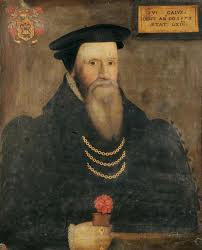





1552 On Jan. 22 Edward Seymour, 1st duke of Somerset (b. 1506) is beheaded on Tower Hill for treason and his properties confiscated, leaving his son Edward Seymour, 1st earl of Hertford (b. 1539) up the creek until he regains his title and lands in 1559, only to get in his own trouble by marrying bad vibes Lady Catherine Grey; John Dudley abolishes his old office (1547-9) of lord protector. On June 17 King Edward VI College in Stourbridge, Worcestershire, England is founded by King Edward VI; in Sept. 1976 it becomes a selective six form college for students age 16-19 with enrollment of 1.6K. Give us Count Chocula? In July 80K Ottomans take Temesvar (Timosoara) in W Romania, along with most of Transylvania, and organize S Transylvania as a province of Temesvar, but the war over it continues for a decade with desultory sieges on the frontier and naval battles in the Mediterranean; on Sept. 4 they take Szolnok in C Hungary; the Siege of Eger in N Hungary E of the Matra Mts. sees 2K Christian forces under Capt. Baron Istvan Dobo de Ruszka (1502-72) successfully fend them off, checking Ottoman expansion into C and E Europe; too bad, they return and take it in 1596 (until 1687); meanwhile the Turks allow large numbers of Spanish Jews to settle in Temesavar until 1716, when Prince Eugene of Savoy captures it, then orders their expulsion in 1718. On Aug. 31 the Collegium Germanicum et Hungaricum seminary for German-speaking priests is established in Rome by Pope Julius III via the bull Dum solicita; the official Jesuit doctrine is laid down as follows: "To search out the hidden venom of heretical doctrine and to refute it, and then to replant the uprooted trunk of the tree of faith" - hand me some holy fire and axes? In Aug. Ferdinand I arranges the Peace (Treaty) of Passau to end the quarrel between his Roman Catholic brother HRE Charles V and elector Maurice I of Saxony, leader of the Protestants, guaranteeing free exercise of the Lutheran faith pending the full settlement of ecclesiastical differences by the 1555 Diet of Augsburg; in later years it is used as an excuse for Protestants to secularize Roman Catholic Church property - pass it out piece by piece? On Sept. 1 after Maurice's cousin John Frederick I the Magnanimous is released, and after a triumphal march he moves his court to Weimar. The Persians attack the Ottomans, who respond by invading the Kurdish region of Shahrizor in N Iraq until they reach an agreement with local chieftains confirming their allegiance - with nine inch nails? The Ottomans capture Jerusalem, and expel all Christians, turning the Cenacle on Mt. Zion into a mosque; no Christian prays there again until 1948 after the establishment of the Jewish state of Israel. The Ottomans occupy the region of Al-Hasa (Al Ahsa) in E Arabia, turning it into a province, with Muhammad Pasha as gov. 84-y.-o. imperial adm. Andrea Doria fights the Barbary pirates. Ivan IV the Terrible conquers the Muslim Tartar khanate of Kazan, key to the Lower Volga River, Siberia, and Persia, destroying the Kul Sharif (Qolsarif) Mosque, largest in Europe outside of Constantinople (rebuilt in 1996-2005), then begins conquering the Astrakhan Khanate (finished 1556), going on to avg. 50 sq. mi. a day, highest rate of land grabbing until the U.S. rush to the Pacific Coast. Henri II of France, allied with the Protestant Elector of Saxony declares war on HRE Charles V, and the French capture Metz, Toul, and Verdun; the Duke of Alva (Alba) attempts to recapture Metz, but Francois de Lorraine II, 2nd Duc de Guise (1519-63) (known as "the Scarred" from his 1545 Siege of Boulogne wounds) defends it, beginning half a cent. of Guise influence in French affairs; Gaspard de Coligny is made adm. (grand pilot) of the French fleet by Henri II (until 1559). The Book of Common Prayer of Edward VI is revised by Canterbury Archbishop Thomas Cranmer to suit Protestants, complete with no real presence of the Eucharist, although the Black Rubric permits kneeling; no vestments, no signing of the cross at confirmation, no holy oil, no reserved sacraments, no prayers for the departed; Cranmer also writes the Forty-Two Articles of Faith (later reduced to 39) for the Church of England, representing the zenith of Calvinist thought; too bad, after Edward VI dies next year, Mary I makes sure they are never put into action - take out the stuff about adultery? Valdivia ("La Perla del Sur") ("City of Rivers") in S Chile is founded by Pedro de Valdivia. Christ's Hospital (AKA the Bluecoat School, Housey, and CH) is founded in London by Edward VI as a coed boarding school. Flemish cartographer Gerhard Mercator (1512-94) settles in Duisburg, Germany; meanwhile the Reformation takes over the town, and in 1555 the miraculous Salvator Church statue is removed - who cares, Mercator will put the burg on the map? Sports: St. Andrew's Golf Club (Royal and Ancient Golf Club of St. Andrews) is founded in cool beautiful green Scotland; Mary Stuart, Queen of Scots becomes (probably) the first woman golfer, and the first to use a caddy. Architecture: Padua Cathedral in Italy is begun (until 1754). Andrea Palladio (1508-80) designs the symmetrical domed-room-centered pedimented temple porch Villa Capra La Rotonda (Villa Almerico Capra Valmarana) in Vicenza; also the Palazzo Chiericati in Vicenza (finished 1580). Science: English physician John Caius (Kays) (1510-73) (pr. like keys) (of Gonville and Caius College, Cambridge fame) pub. the first clear description of English Sweating Sickness, which first struck England in 1485 and spread to the Continent before vanishing in 1551. Roman anatomist Bartolommeo Eustachio (Lat. "giving fruit") (1500-74) discovers the Eustachian Tubes, the adrenal glands, and the detailed structure of the teeth, but his discoveries are not pub. until 1611 (1714) in Tabulae Anatomicae and Libellus de Dentibus. Nonfiction: William Baldwin (1515-63), Wonderful News of the Death of Paul the Third. Bartolome de las Casas (1474-1566), Brevisima Relacion de la Destruccion de las Indias. Francesco Lopez de Gomara, Historia General de las Indias (1552-3); Cortes' private secy. Nostradamus (1503-66), Moult Utile Opuscule (Very Useful Little Treatise); a book of gastronomic, medical, and cosmetic recipes written at the request of his sole Protestant friend Jeanne d'Albret, mother of future Henry of Navarre; enlarged ed. pub. 1555. Georg Joachim Rheticus (1514-74), Canon of the Science of Triangles; first Euro pub. of 6-function trig tables. Pontus de Tyard (1521-1605), Solitaire Premier, ou Prose des Muses, et de la fureur poetique (poétique); his theory of divine fury based on Marsilio Ficino's translations of Plato's "Ion" and "Phaedrus". Art: Titian (1477-1576), Self-Portrait. Plays: Etienne Jodelle (1532-73), Cleopatre Captive; first classical tragedy in French? Poetry: Pierre de Ronsard (1524-85), Amours (vol. 1). Births: English jurist-statesman Sir Edward Coke (d. 1634) (pr. like cook) on Feb. 1 in Mileham, Norfolk; educated at Trinity College, Cambridge U. French "Les Tragiques" Huguenot chronicler-poet-gen. Theodore Agrippa d'Aubigne (d'Aubigné) (d. 1630) on Feb. 8 near Pons, modern-day Charente-Maritime; flees to Geneva in 1620. Austrian HRE (1576-1612) (Roman Catholic) Rudolf II (d. 1612) on July 18 in Vienna; son of Maximillian II (1527-76) and Maria of Austria (1528-1603). Italian painter Lavinia Fontana (d. 1614) on Aug. 24 in Bologna; daughter and pupil of Prospero Fontana (1512-97); first prof. woman artist in Europe? English "The Faerie Queene" poet Edmund Spenser (d. 1599) (b. 1553?) in London; coins the word "prothalamion" ("before the bridal chamber"), meaning a song celebrating marriage, complementing the word "epithalamion", a nuptial song. Italian jurist-philosopher Alberico Gentili (d. 1608) on Jan. 14 in San Ginesio, Marche; educated at the U. of Perugia. Italian Catholic missionary (to China) Matteo Ricci (d. 1610). German painter Hans von Aachen (d. 1615) in Cologne; his father comes from Aachen; pupil of E. Jerrigh and Kaspar Rems; teacher of Peter Isaak and Joseph Heinz. English geographer-chronicler Richard Hakluyt (d. 1616); educated at Westminster School, and Christ Church, Oxford U. English soldier-explorer-courtier-historian and tobacco-head ("the Fox") ("Knight of the Cloak") Sir Walter Raleigh (d. 1618) on Jan. 22 in Hayes Barton, East Budleigh, Devonshire; attends Oxford U. for 1 year (1568-9); knighted in 1584. English poet-historian Samuel Daniel (d. 1619) nar Taunton, Somerset; brother of John Daniel; educated at Hertford College, Oxford U. Italian priest-scholar Paolo Sarpi (d. 1623). Spanish explorer and gov. of New Spain Don Juan de Onate (Oñate) Salazar (d. 1626) in Zacatecas, Mexico; son of Cristobal de Onate (1504-67). Deaths: Swiss Protestant theologian Oswald Myconius (b. 1488) on Oct. 14 in Basel. German humanist writer Johannes Cochlaeus (b. 1489). Swedish reformer Olaus Petri (b. 1493). Chinese artist Qiu Ying (b. 1494); leaves Spring Morning in the Han Palace. Spanish viceroy #1 of New Spain (1535-50) and viceroy #3 of Peru (1551-2) Antonio de Mendoza (b. 1495) on July 21 in Lima, Peru. Italian Franciscian priest Matteo Sarafini (b. 1495) in Venice. German Lutheran theologian Andreas Osiander (b. 1498) on Oct. 17 in Konigsberg, Prussia. German Martin Luther's wife Katharina von Bora (b. 1499) on Dec. 20 in Torgau, Saxony. English lord protector Edward Seymour, 1st duke of Somerset (b. 1506) on Jan. 22 in London (beheaded). Jesuit missionary ("the apostle of the Indies") (first Jesuit saint) St. Francis Xavier (b. 1506) on Dec. 3 on Sancion Island off the Chinese mainland 90 mi. W of Macao.
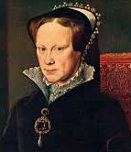

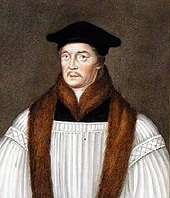







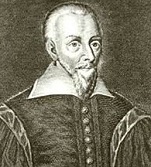
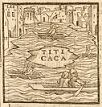




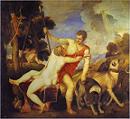

1553 On Apr. 29 Flemish woman Dinghen Vauden Plasse (Mrs. Dingheim) , introduces the practice of starching of linen into England. Nausea, heartburn, indigestion, upset stomach, diarrhea, Bloody Mary is maximum pink? Or, hit it, Mrs. Church? On May 25 as part of a Protestant plot by John Dudley, duke of Northumberland, 15-y.-o. Lady Jane Grey (1537-54) (cousin of Edward VI, great-niece of Henry VIII, and great-granddaughter of Henry VII) (who knows Latin, Greek, and Hebrew) marries his son Guilford (Guildford) Dudley (1536-54), brother of horsemaster Robert Dudley, earl of Leicester; on July 6 after the king's council signs the handwritten King's Device, English king (since 1547) Edward VI (b. 1537) dies of TB; in it he passes over his half-sisters Mary Tudor and Elizabeth for Protestant Lady Jane Grey (1537-54) ("the 9-day queen") (sometimes called the 13-day queen when July 6 is counted), and after Thomas Cranmer forgives his pledge to carry out Henry VIII's will giving it to Mary Tudor, she is proclaimed queen on July 10 in the Tower, and struts her royal stuff until July 19 (never leaving the Tower), with Edward's Greek tutor Sir John Cheke as secy. of state; John Dudley tries to capture Mary in Norfolk and is instead captured in July; meanwhile Mary gathers her forces in East Anglia, and on July 19 after being accompanied by a large force to London along with future Elizabeth I, militant Roman Catholic Mary I Tudor (1516-58), duchess of Suffolk (granddaughter of Ferdinand II and Isabella I the Catholics), later known as Bloody Mary is proclaimed queen (the 42nd British monarch) (until Nov. 17, 1558); the military show of support causes Lady Jane Grey's supporters to fold, and she and her husband are arrested on July 20; Mary I is crowned on Oct. 30 in Winchester Cathedral, immediately signaling a return to Roman Catholicism, and signing a marriage treaty with her cousin Philip II of Spain, promising him the title of King of England without the powers or the succession, triggering Wyatt's Rebellion, with a Protestant army headed by Sir Thomas Wyatt the Younger (1521-54) (son of poet Sir Thomas Wyatt, father of the English sonnet), which heads for London, where they are defeated and the leaders executed by next year, with Elizabeth locked up for almost a year, escaping being implicated in the plot by a hair; too bad, Lady Jane Grey (who has been spared so far and kept in the Tower) is implicated, so her head is on the chopping block with theirs; meanwhile Stephen Gardiner (1483-1555), bishop of Winchester becomes lord chancellor, and soon heads begin to roll; John Knox flees to Geneva to be with John Calvin; St. Paul's chaplain Edmund Grindal flees to Germany (until 1559); Sir John Cheke is imprisoned; Miles Coverdale is removed as bishop of Exeter and imprisoned for two years, then goes into exile for eight years in the Continent (Wesel, Bergzabern, Geneva) (until 1559); after returning to England from exile after the death of Henry VIII in 1547 and being received by Edward VI, who restores his lands, Gerald FitzGerald (1525-85) is restored as 11th Earl of Kildare for his help in suppressing the rebellion, and returns to Ireland, becoming known as "the Wizard Earl" for his interest in alchemy and magic; Thomas Cranmer is reprimanded and confined to his palace at Lambeth, and arrested on Sept. 14 then imprisoned in the Tower of London; Edmund Bonner is released, and goes completely Catholic, becoming known as "Bloody Bonner" for his zealous persecution of Protestants; Thomas Howard, 3rd duke of Norfolk is released from the Tower, and his lands and titles restored, keeping the resilient Howard name going, with his grandson Thomas Howard, 4th Duke of Norfolk (1536-72), son of his dead son Henry Howard inheriting the dukedom on his death next year; on Aug. 23 John Dudley is beheaded after feigning conversion to Roman Catholicism; his son Robert Dudley (b. 1533) (who became an MP this year) supports his father, and ends up in the Tower under sentence of death at the same time that Elizabeth is imprisoned there, sparking rumors that they begin a romance, despite him being married? On July 9 the Battle of Sievershausen between Sievershausen and Arpke in modern-day Lehrte, Germany sees 18K troops under elector Maurice I of Saxony and duke Henry V of Brunswick-Luneburg defeat 15K troops under Franconian Hohenzollern margrave Albert II Alcibiades "the Warlike" of Brandenburg-Kulmbach (1522-57) after 4K are killed on both sides, incl. Maurice (friendly father) and two of Henry's sons; Maurice's younger brother Augustus I (1526-86) becomes elector of Saxony (until Feb. 11, 1586); in 1967 the local parish church becomes the site for German peace groups to meet; in 1979 they build an anti-war museum there. In July the Spanish capture and sack Hesdin in Pas de Calais in N France on the Canche River. On Aug. 17 Charles III (b. 1486) dies, and his only son Emmanuel "Iron Head" Philibert (1528-80), who had helped capture Hesdin in July becomes duke of Savoy (until Aug. 30,, 1580), going into the dirty-deeds-done-dirt-cheap biz to try and get his hereditary lands back from the French, who had been administering them since 1536. On Oct. 5 the First Parliament of Bloody Mary I meets, repealing Edward VI's Treason Act along with his religious legislation, passing an act declaring the legitimacy of Mary I, and reinstating the Latin Mass, celibacy of the clergy, and ritual worship, wiping out Edward VI's entire work. On Oct. 27 Swiss Protestant leader John Calvin (1509-64) burns his theological enemy, Unitarian (non-Trinitarian) Catalan scholar Michael Servetus (b. 1511) (who was captured while fleeing to his protection after escaping a prison of the Spanish Inquisition) in Geneva, executioner Guillaume Farel warning the audience: "(Servetus) is a wise man who doubtless thought he was teaching the truth, but he fell into the hands of the Devil... Be careful the same thing doesn't happen to you"; liberals lose their illusions about Bible-thumpers ever lightening up anything but a faggot, and a corner is turned in the fight for freedom of conscience?"; at his trial Servetus is ridiculed for describing Palestine as a sparse, sterile land when the Bible says it's the land of milk and honey; noted noble Paris-educated French Protestant ex-humanist poet Theodore Beza (1519-1605) backs Calvin up - I look bad, feel bad, which is most important? On Dec. 25 Chilean gov. #1 (1540-7, 1549-) Pedro de Valdivia (b. 1497) is KIA in the Battle (Disaster) of Tucapel near Ft. Tucapel in a revolt of the Mapuche (Araucanian) Indians (captured then executed?), led by Lautaro ("swift hawk") (1534-7) (his former servant, who escaped and taught the Mapuches how to ride horses), stopping the Spanish advance; too bad, Mapuches have to have a lengthy V celebration, which allows the Spaniards to regroup in Concepcion. The Ottomans ravage part of Persia, but the shah's army withdraws into the mountains of Luristan. Sultan Suleyman has his (most able?) son Mustafa, gov. of Amasya strangled for planning an uprising. Queen Mary I proves herself English first and Roman Catholic second by ordering the Irish pop. of Kings and Queens County driven out and their lands given to English colonists, becoming the first English monarch to try colonizing butt-of-the-joke Ireland with stankin' English settlers. Sebastian Cabot (1476-1557), son of John Cabot (d. 1498) convinces merchants to back him in an expedition sailing NE from England, above Scandinavia, in a fruitless search for a northeast passage; Sir Hugh Willoughby (-1554) of the Bona Esperanza, Cabot of the Bona Confidentia, and Richard Chancellor (-1556) of the Edward Bonaventure, backed by the Mystery Co. and Fellowship of Merchant Adventurers for the Discovery of Unknown Lands of London sail to the Arctic; after being separated by "terrible whirlwinds", on Sept. 14 Willoughby sails into a bay between Russia and Finland, and discovers Novaya Zemlya, while Cabot returns to England, and Chancellor anchors in the White Sea and trudges overland to Moscow to the court of Ivan IV the Terrible, where he is warmly welcomed, wined, and dined, opening English trade with Russia; Willoughby dies during the winter on the Kola Peninsula on the Lapland coast early next year, and the frozen bodies of him and his crew, along with his journals are found by fisherman a year later. Tonbridge School in Kent, England is founded by London lord mayor Sir Andrew Judde (Judd) (1492-1558), who leaves it in his will to the Worshipful Co. of Skinners in London. Bridewell Prison in London, England is founded (until 1700) in a brick palace around three courtyards built for Henry VIII near St. Bride's (St. Bridget's) Well on the banks of the Fleet River in London (scene of the 1533 Hans Holbein painting "The Ambassadors"), pioneering hard labor instead of corporal or capital punishment and creating the first "penitentiary", hoping to make criminals penitent; after it develops shocking conditions, the term "bridewell" is used in Britain to differentiate hell-holes from mere prisons until 1865. Architecture: The Renaissance Old Palace (Altes Schloss) in Stuttgart, Germany is built. The 5 mi. x 2 mi. oblong Chinese City (Nan Cheng) S of Tartar City in Peking begins contruction (finished 1564), surrounded by a 30-ft.-high wall. Palladio designs the Villa Pisana in Montagnana. Paolo Veronese does the Ceiling of the Doge's Palace in Venice. Inventions: The first modern violin is developed. Giovan Batista Belaso invents the Vignere Cipher, containing the idea of the password in cryptography. Science: French naturalist Peter Baleen, er, Pierre Belon (1517-64) pub. De Aquatilibus, the first scientific study of marine animals, revealing that cetaceans (whales, dolphins, porpoises) breathe air with lungs, and other shocking discoveries. Before being burned, Catalan scholar Miguel Serveto (1511-53) pub. Christianismi Restitutio, a theological discussion in which he mentions that blood passes from the right to left ventricle via the lungs, where it changes color, becoming the first Westerner to pub. the theory of the pulmonary circulation; he had been a pupil of Johannes Gunther of Andernach in Paris at the same time as Vesalius. Nonfiction: Pedro de Cieza de Leon (1520-54), Chronicle of Peru (vol. 1 of 4); written by a Spanish conquistador; the first Euro pub. to mention the potato; the last 3 vols. are pub. in the 19th and 20th cents. Leonard Digges (1520-59), A General Prognostication; bestselling almanac with a perpetual calendar and astronomical material; title changed in 1556 to "A Prognostication Everlasting". Sir Thomas More, A Dialogue of Comfort Against Tribulation (posth.). Domingo de Soto, De Justicia et Jure. Samuel Usque, Consolations for the Tribulations of Israel; Portuguese Jew tells of the joys of emigration from Jew-persecuting Europe to Jew-tolerating Turkey, "a broad and spacious sea which God opened with the rod of His mercy as He opened the Red Sea at the time of the Exodus... Here the gates of liberty are always open for the observance of Judaism." Thomas Wilson, The Arte of Rhetorique. Art: Titian (1477-1576), Venus and Adonis. Plays: Hans Sachs (1494-1576), Tristan und Isolde. Nicholas Udall (1504-56), Ralph Roister Doister; the first English comedy; contains hidden pederasty messages?; not pub. until 1567; wealthy widow Christian Custance is wooed by Ralph Roister Doister even though she is betrothed to Gawyn Goodluck, and when she spurns him he tries taking her by force but her servants stop him and he runs away, after which Goodluck gets lucky and there's a happy ending. Novels: William Baldwin (1515-63), A Marvellous History Intituled Beware the Cat; pub. 1570; the first English novel? Births: Prussian duke #2 (1568-1618) Albert Frederick (Albert Friedrich) (d. 1618) on May 7; son of Albrecht I (1490-1568) and Anna Marie of Brunswick-Luneburg; last duke of the Ansbach branch of the Hohenzollern family. French queen consort of Navarre (1572-99) and queen consort of France (1589-99) Margaret of Valois (Marguerite de Valois) (Margaret of France) (Queen Margot) (d. 1615) on May 14 in Chateau de Saint-Germain-en-Laye; younger daughter of Henry II (1519-59) and Catherine de' Medici (1519-89); sister of Frances II, Charles IX, Henry III, and Elizabeth of Valois; queen (1572-99) of Henri IV (Henry of Navarre). Italian physician-botanist Prospero Alpino (ALpinio) (Alpinio) (Alpin) (d. 1617) on Nov. 23 in Marostica (near Vicenza); educated at the U. of Padua; father of Alpino Alpini (-1637). French Bourbon king #1 (1589-1610) and king of Navarre (1572-1610) "Good King" Henri IV (Henry III of Navarre) (d. 1610) on Dec. 13/14 in Pau, Bearn, Navarre; son of Antoine de Bourbon, duc de Vendome and Jeanne d'Albret (Jeanne III of Navarre) (1528-72), daughter of Margaret of Navarre; head of the Protestant Party in France who converts to Catholicism to secure his throne; father of Louis XIII (1601-43), Elisabeth of Bourbon (1602-44), and Henrietta Maria of England-Scotland (1609-69); his unlikely rise to the throne of France was predicted by Nostradamus in Century 5, Quatrain 41? Italian composer and madrigal king Luca Marenzio (Marencio) (d. 1599). English "Euphues" dramatist-poet John Lyly (d. 1606) in Kent; educated at Magdalen College, Oxford U. German chorale composer Johannes Eccard (d. 1611) in Muhlhausen, Thuringia. English lexicographer-linguist John (Giovanni) Florio (d. 1625) in London; Roman Catholic-turned-Protestant Italian immigrant father Michelangelo Florio is tutor of Elizabeth I and Lady Jane Grey; devotes his life to civilizing the barbaric English with Italian culture and proverbs; friend of William Shakespeare and Giordano Bruno; inspires Holofernes in "Love's Labour's Lost?" Spanish valido Francisco Gomez (Gómez) de Sondoval y Rojas, 1st Duke of Lerma (d. 1625) (b. 1552?) in Tordesillas, Castile and Leon; first of the validos (Sp. "most worthy", favorites of the Hapsburg kings ruling Spain. Deaths: German painter Lucas Cranach the Elder (b. 1472) on Oct. 16 in Weimar. Spanish scholar Hernan Nunez (b. 1475) in Salamanca. Italian physician Fracastorius (b. 1478) on Mar. 17 in Verona. Spanish conquistador Francisco de Montejo (b. 1479) in Spain. Italian physician-poet-astronomer Girolamo Fracastoro (b. 1483). Italian duke of Savoy (1504-53) Charles III (b. 1486) in Aug. Italian painter Bonifazio Veronese (b. 1487). German statesman Jacob Sturm von Sturmeck (b. 1489) on Oct. 30 in Strasbourg. German prince-bishop Franz von Waldeck (b. 1491). French humanist philosopher Francois Rabelais (b. 1494) on Apr. 9 in Paris; last words: "I am going to a great perhaps"; his last will: "I have nothing. I owe much. The rest I leave to the poor"; "If you wish to avoid seeing a fool you must first break your mirror." Spanish conquistador Pedro de Valdivia (b. 1497) on Dec. 25 in Tucapel, Canete, Chile (KIA). English soldier John Dudley, viscount Lisle, earl of Warwick, and duke of Northumberland (b. 1502). German astronomer Erasmus Reinhold (b. 1511) on Feb. 19 in Saalfeld, Thuringia. Spanish super scholar-scientist-physician Miguel Serveto (Michael Servetus) (b. 1511) on Oct. 27 in Geneva (burned by Caligula Calvin); last words: "Jesus, Son of the Eternal God, have mercy on me"; leaves Universal Treatise on Syrups (pioneer book in pharmacology and vitamins) - the good burn out young? Italian travel writer Ortensio Landi (b. 1512); leaves Travel Diaries which mention macaroni and say that it is given the name of the beatified. German elector of Saxony (1547-53) Maurice I (b. 1521) on July 9 in Sievershausen (KIA). Ottoman adm. Sinan (Sinauddin Yusuf) Pasha (b. ?) on Dec. 21 in Istanbul. French ambassador to Constantinople (1546-53) Gabriel de Luetz, Baron et Seigneur d'Aramon et de Vallabregues (b. ?).


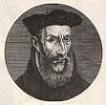


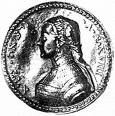



 "
"
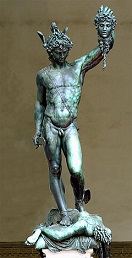
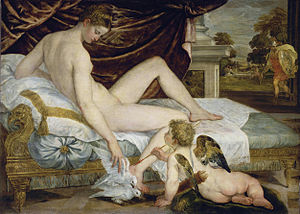
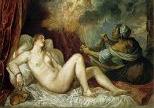
1554 On Jan. 25 Sao Paulo in SE Brazil (modern-day pop. 12M/21.2M) is founded by Jesuit missionaries Manuel da Nobrega and Jose de Anchieta on an Indian campsite 45 mi. from the coast. On Feb. 12 Lady Jane Grey (b. 1537) and her husband Guildford Dudley (b. 1534) are beheaded for treason. On Feb. 23 5K Mapuch warriors under chief (toqui) Lautaro battle 180 Spanish soldiers and 1.4K-2.1K Indian auxiliaries under Francisco de Villagra (1511-63) at the Marihueno (Marihueñu) Hill, and score a V, killing 84 Spaniards and most of the auxiliaries, and capturing all the artillery, but the lengthy V celeb allows the Spaniards to regroup in Santiago, by which time the Mapuches catch smallpox from them. On Mar. 3 John Frederick I the Magnanimous (b. 1503) dies, and his eldest son John Frederick II (1529-95) succeeds him as duke of Ernestine Saxony (until Nov. 1566), moving his court to Gotha; he gives his younger brothers Johann Wilhelm (1530-73) (Weimar) and Johann Frederick III (1538-65) (Gotha) a split of his lands, keeping Eisenach and Coburg, later absorbing Gotha on the death of JFIII in 1565; meanwhile recovers the title of elector of Saxony, but loses it again in 1556, after which he begins an ill-fated war against the HRE to get it back. On Mar. 16 the body of St. Francis Xavier arrives in Goa to a celebration; the next day the body is examined and declared to have no sign of decay, causing a brisk business in his holy remains for curative purposes. On Mar. 23 (Good Friday) Nostradamus (1503-66) writes his first quatrain after evoking his demon in accordance with rites prescribed by Michael Psellus the Elder (1019-78) in De Daemonibus? In Mar. after being condemned to death for treason by a secular court but the sentence not carried out, then held for trial for heresy after Parliament reestablishes papal jurisdiction, Thomas Cranmer is moved to a common prison in Oxford, where he is coerced into making seven recantations of his earlier beliefs, proclaiming faith in the articles of the Roman Catholic Church and repudiating his writings, which doesn't save him from being deposed from his archbishopric and excommunicated, and condemned by a secular court to burning at the stake; meanwhile the revolt against Mary peaks and fails, and several nobles are executed. On Apr. 12 the Earl of Arran is removed, and Mary de Guise becomes regent of her French-fried daughter Mary, Queen of Scots. On July 26 38-y.-o. Queen Bloody Mary the Catholic of England marries 27-y.-o. Spanish king (1556-98) Philip II (the Prudent) (1527-98), son of Inquisition-loving HRE Charles V (his 2nd wife after Mary of Portugal, mother of Don Carlos de Austria), who is made king of Naples by his father as a wedding gift, and together they officially restore the Roman Catholic Church in England, reviving the 1401 De Heretico Comburendo act so they can burn heretics (300+ total starting in Feb. 1555, some getting bags of gunpowder tied to their legs to finish them off quickly); Philip II is now king of England, and Mary falls madly in love with him; Mary's popularity in England at first soars when she announces that she's preggers, and therefore her Catholic dynasty is here to stay, then plummets after it turns out to be a fantasy in 1555 and they joke about her being pregnant with a lapdog; meanwhile she imprisons her half-sister and heir presumptive Elizabeth Tudor on false charges of participating in Wyatt's Rebellion, along with Sir John Harrington and his wife Isabella Markham, who are rewarded in 1561 by Liz by standing godmother to their eldest son John (she is later released, after professing to be Catholic); Robert Dudley is released from the Tower after Philip II intercedes. In Sept. John Knox travels to Frankfurt to pastor English refugees from Mary's persecution. In Dec. Francisco Hernando Giron is executed, ending the Spanish revolt in Peru (begun 1550). The Portuguese defeat an Ottoman fleet off Hormuz, preventing them from controlling the Persian Gulf, and closing it to Ottoman shipping. HRE Charles V obtains a bull from Pope Julius III granting him a dispensation from fasting, and allowing him to break his fast early in the morning even when he is to take the sacrament; "Fish of every kind was to his taste, as, indeed, was anything that in its nature or habits at all approached to fish. Eels, frogs, oysters, occupied an important place in the royal bill of fare" (H.G. Wells, vol. 2, p. 634). A Persian army defeats a Turkish force under Suleiman I at the Battle of Bitlis 15 mi. SW of Lake Van, and Suleiman makes peace with Persia, retaining Mesopotamia. Japan invades Zhe Jiang. Dragut begins attacking Hapsburg outposts in N Africa. Wealthy Spanish Marrano Jewish businessman Don Joseph Nasi (1524-79) moves to Constantinople from Venice after sidestepping the Inquisition in Spain, Portugal and Antwerp, and begins financing the rise to power of Suleiman's son Selim II, working with his rich Portuguese-born aunt Dona Gracia Nasi Mendes (1510-69), who moved there the previous year, both of them and their families giving up the Christian conversion act and openly living as Christ-habit-kicking Jews. Sir John Cheke is released from prison and permitted to travel on the Continent and teach until 1556, when he is forced to return to England as a political prisoner and become a Catholic to please Queen Mary. Antonio Moro becomes court painter to Philip and Mary. London trader John Lok (Locke) leads a voyage to Guinea, and next year becomes the first Englishman to bring slaves from Africa, a whopping five - let's bungle in the jungle, well that's all right by me? Mines in Saxony come under state supervision. Shanghai, China builds a 3-mi.-long 33-ft.-high wall to protect itself from raids by Japanese pirates. Architecture: Ottoman chief architect Mimar Sinan (1489-1588) begins the Madrasa (religious college) and Takiyye Mosque (Sufi lodge) in Damascus (finished 1566). Science: Realdo Colombo's Catalan pupil Juan Valverde de Amusco (Hamusco) (1525-?) pub. the first account of the Pulmonary (Lesser) Circulation. Swiss naturalist Conrad Gessner pub. the first scientific description of the Guinea pig; the earliest known portrait of a guinea pig is painted in Elizabethan England in 1580. Nonfiction: Ulisse Aldrovandi (1522-1605), Herbarium (17 vols.); biggest herbarium of the cent. Theodore Beza (1519-1605), De Heraeticis a Civili Magistratu Puniendis; defends the burning of Servetus. Sebastian Castellion (1515-63), Concerning Heretics (De Haereticis); treatise against religious persecution; pub. anon. Diego de Covarrubias y Leiva (1512-77), Variarum; first explanation of the source of economic value; "The value of an article does not depend on its essential nature but on the estimation of men, even if that estimation is foolish." Rembert Dodoens (1517-85), Cruydeboeck (herbal); divides the plant kingdom into six groups. Louis of Granada (1505-88), The Book of Prayer and Meditation; a hit, launching his writing career while living an ascetic life. Joseph ben Ephraim Karo (1488-1575), Shulchan Aruch; last great codification of Jewish law. Francisco Cervantes Salazar, Chronicles of New Spain; first mention of the avocado (alligator pear) as growing in Mexico. Juan Valverde de Amusco, Anatomia del Corpo Umano. Novels: Anon., Lazarillo de Tormes; autobio. of a Spanish boy rogue who takes advantage of his many masters, founding the picaresque (Sp. "picaro" = rogue) genre of fiction. Matteo Bandelle, Le Novelle; 214 short stories. Jorg Wickram, Der Goldfaden. Art: Benvenuto Cellini (1500-71), Perseus with the Head of Medusa (1545-54) (Apr. 27) (bronze sculpture); debuted in the Loggia dei Lanzi in the Piazza della Signoria in Florence, joining Michelangelo's David, Donatello's Judith and Holofernes, and Bandinelli's Hercules and Cacus; the first statue since antiquity where the base incl. a figurative sculpture forming an integral part of the work. Hans Eworth (1520-74), Mary I. Lambert Sustris (1515-84), Venus and Love. Titian (1488-1576), Danae and the Shower of Gold; manly woman raises her hip in expectation of a little hanky panky?; best handling of color ever, although Michelangelo claims that the drawing behind it is deficient? Births: Portuguese Avis king #16 (next to last) (1557-78) Sebastian (Sabastiao) I (the Desired) (d. 1578) on Jan. 20 in Ribeira Palace, Lisbon; posth. son of Prince John Manuel (1537-54); grandson of Joao III (1502-57). Spanish Carmelite nun Marina de Escobar (d. 1633) on Feb. 8 in Valladolid; establishes a Brigittine (literary) Catholic order in Spain. French Catholic League leader Charles of Lorraine, Duke of Mayenne (Charles de Guise) (d. 1611) on Mar. 26 in Alencon; 2nd son of Francis of Lorraine II, duke of Guise (1519-63) and Anna d'Este, daughter of Ercole d'Este II, duke of Ferrara and Renee of France. Russian tsarevich Ivan Ivanovich (d. 1581) on Mar. 28; eldest son of Ivan IV the Terrible and 1st wife anastasia Romanovna; brother of Feodor I (1557-98). English priest-theologian Richard Hooker (d. 1600) in Mar. in Heavitree (near Exeter), Devon; educated at Corpus Christi College, Oxford U.; spends his life defending the Anglican form of church org. against Presbyterianism. English anti-theater clergyman writer Stephen Gosson (d. 1624) on Apr. 17 in Canterbury; educated at Corpus Christi College, Oxford U.; rector at Great Wigborough, Essex (1591) and St. Botolph's, Bishopgate (1600). Belgian (Flemish) "On Justice and Law" moral theologian (Jesuit) Leonardus Lessius (Lenaert Leys) (d. 1623) on Oct. 1 in Brecht. English poet-playwright-statesman Sir Fulke Greville, 1st Baron Brooke (d. 1628) on Oct. 3 in Beauchamp Court (near Alcester), Warwickshire; educated at Shrewbury School (where he becomes friends with Sir Philip Sidney), and Jesus College, Cambridge U.; created baron in 1621. English "Astrophel and Stella" poet-soldier-courtier Sir Philip Sidney (d. 1586) on Nov. 30 in Penshurst Place (near Tunbridge Wells), Kent; educated at Shrewbury School, and Christ Church, Oxford U.; knighted in 1583. French fortifications expert Jean Errard (d. 1610). English theologian-bishop Miles Smith (d. 1624) in Hereford; educated at Corpus Christi College and Brasenose College, Oxford U. Flemish landscape painter Paul Bril (d. 1626); brother of Mathys Bril (1550-84). English adventurer Sir John Lancaster (d. 1618). Deaths: Ottoman adm. Piri Reis (b. 1465). English soldier Thomas Howard, 3rd duke of Norfolk (b. 1473) on Aug. 25. Italian architect Sebastiano Serlo (b. 1475) in Lyons, France. Italian painter Il Moretto (b. 1498). German elector John I the Magnanimous of Saxony (b. 1503) on Mar. 3 in Weimar. Spanish explorer Francisco Vasquez de Coronado (b. 1510) on Sept. 22 in Mexico City. German duchess Sybille of Cleves (b. 1512) on Feb. 21 in Weimar. English nobleman (Lady Jane Grey's father) Henry Grey, 1st duke of Suffolk (b. 1517) on Feb. 23 (beheaded for high treason in the Wyatt Rebellion); his head in oak sawdust is discovered in London's Holy Trinity Church in 1851. Spanish conquistador-chronicler Pedro Cieza de Leon (b. 1520) in Seville. English rebel Sir Thomas Wyatt the Younger (b. 1521) on Apr. 11 in Tower Hill, London (beheaded); his head is hung on a gallows until it is stolen on Apr. 17; his limbs are circulated around England. English almost-king Guilford Dudley (b. 1536) on Feb. 12 (beheaded). English queen Lady Jane Grey (b. 1537) on Feb. 12 (beheaded).










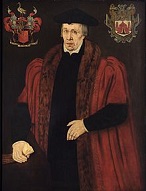
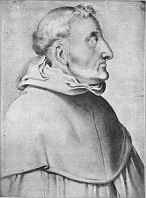

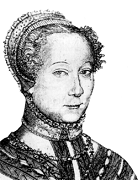
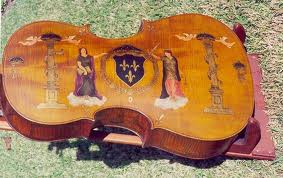

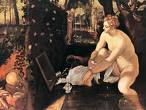
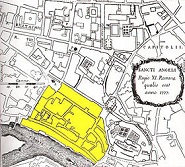

1555 On Mar. 23 Pope (since 1550) Julius III (b. 1487) dies, and on Apr. 9 Marcello Cervini Degli Spannochi is elected Pope (#222) Marcellus II (1501-55); he dies after a reign of 22 days on Apr. 30-May 1, and on May 23 ardent Italian nationalist and narrow intolerant bigot Giovanna Pietro Carafa is elected Pope (#223) Paul IV (1476-1559) (until Aug. 18, 1559), going on to stink up the Roman Catholic Church as the Father of the Roman Inquistion, cutting off Michelangelo's pension and ordering the nudes in his Last Judgment in the Sistine Chapel to be clothed, then persecuting the Spirituali, which Michelangelo is a secret member of, who want to reform the Church without going Protestant; on July 14 he issues the anti-Semitic bull Cum Nimis Absurdum ("Since it is absurd and utterly inconvenient to be in a situation where the pesky Jews - who through their own fault were condemned by God to perpetual slavery - have access to us or even our society... and instead of the slavery they deserve, they dare to claim superiority over us..."), setting up the first-ever legally compulsory Jewish ghetto in Rome, surrounded by brick walls and locked at night, with punishments for being caught out at night, esp. without wearing the yellow star of David on their clothing, plus a yellow hat for males and yellow kerchief for females (the original yellow safety clothing?) (the Satan-worshipers might try to get some Christian infants for who knows what, I can't control myself, burn baby burn?); as self-chosen slaves who reject Our Dear Lord, Jews are prohibited from owning real estate or practicing medicine; by 1870 Rome has the last legally compulsory ghetto in Europe, which is abolished by King Victor Emmanuel - here comes the rooster? On Apr. 30 crowds gather in London to await news of the birth of a baby to Queen Mary after she had proclaimed her pregnancy, only to figure out by June that it is imaginary, and her hubby Philip II didn't have the heart; meanwhile on May 4 Nostradamus pub. the first ed. of his Centuries, perhaps in a rush to predict the future of a new heir to the Tudors and Hapsburgs who will unite all of Europe incl. Britain under the Roman Catholic Holy Roman Empire - somehow I get it, I would sell my very soul and not regret it, for to live without your love is just impossible? In Apr. the free town of Siena, Italy, which had held out with French help finally falls to the Florentine states. On May 25 Henry II of Navarre (not to be confused with Henry II of France) is killed in a riding accident, and his son-in-law Duke Anthony of Bourbon-Vendome (head of the House of Bourbon since 1537) becomes king Anthony (Antoine) of Navarre (Bourbon) (1518-62), giving the House of Bourbon its first throne. On May 29 the Ottomans and Persians agree to the Peace of Amasya, defining the border between Persia and the Ottoman Empire, and giving permission to Persian pilgrims to visit Mecca and Medina; meanwhile a revolt against the Ottoman sultan in Macedonia and Thrace is led by a man claiming to be the dead (executed in 1553?) prince Mustafa, but Suleyman's son Bayezid suppresses it and executes him right this time? On July 19 after Henry VIII travels to Portsmouth and watches from shore, his fleet fights a French fleet of 230 ships; too bad, Henry's favorite ship, the carrack-style Mary Rose (launched July 1511) is sunk in the Solent Straits N of the Isle of Wright, along with vice-adm. Sir George Carew (b. 1504); it is rediscovered in 1971, and salvaged in 1982 and put in a museum. Ow? Ow? Augsburg? On Sept. 25 after HRE Ferdinand I attends the Diet of Augsburg to force the 225 German princes to agree, the Peace of Augsburg (Augsburg Settlement) is signed by HRE Charles V, giving imperial recognition to the 1530 Confession of Augsburg, granting Lutheran (not Calvinist) states equal rights with Roman Catholic states, and establishing the principle "cuius regio ejus religio" (the confession of the subject is dependent on that of the territorial prince), incl. the right to introduce the Lutheran faith (jus reformandi), although no provision is made for the Calvinist faith; by imperial decree Roman Catholic bishops and abbots who go Lutheran lose their offices and incomes; the Holy Roman Empire (and the idea of world imperialism?) begins to decay, leading to a bunch of personal one-valley monarchies, and eventually to the Thirty Years' War (1618-48). In Sept. Philip II, pleading important royal business (fed-up with his ditsy wife?) leaves England (until 1557). On Oct. 16 English Protestant bishops Hugh Latimer (b. 1485) and Nicholas Ridley (b. 1500) are burned at the stake by Bloody Bonner under the orders of Bloody Mary, while Archbishop Thomas Cranmer is forced to watch from Bocardo Prison in Cornmarket; Latimer's last words: "Be of good cheer, Master Ridley, and play the man, for we shall this day light such a candle in England as I trust by God's grace shall never be put out." On Oct. 25 gout-ridden HRE Charles V officially abdicates as duke of Burgundy, giving rule of the Low Countries (Netherlands and Belgium) to his son Philip II; during the ceremony Charles V leans on the shoulder of William I the Silent, Prince of Orange (1533-84), who converts from Lutheran to Roman Catholic to please him, and is given command of troops on the French frontier. On Nov. 13 Thomas Cranmer is deposed as archbishop of Canterbury (enthroned Mar. 30, 1533). In Dec. Pope Paul IV forms a new league to kick the Spanish out of the Papal States, with the French agreeing to ally with the pope and Ferrara to conquer Milan and Naples, then to set up French princes to rule with the pope as suzerain, and also to kick the Medici out of Florence and restore the repub.; Charles of Guise, cardinal of Lorraine signs for France. Hapsburg Duke Cosimo unsuccessfully defends Elba and the surrounding areas from the French, who ravish them. French pirates plunder Havana. Japanese pirates seige Nanking. French knight Nicolas Durand de Villegagnon, having become disillusioned by the failure of the Order of St. John to hold Tripoli against the Turks leads a group of French Huguenots to Brazil, and discovers the site of Rio de Janeiro. English capt. Sir John Hawkins (1532-95), backed by a syndicate of wealthy London merchants sails with three ships to the Caribbean via Sierra Leone, hijacks a Portugese slaver and captures 300 African slaves, then sells them in Santo Domingo even after two of his ships are seized by the Spanish, who ban all English ships from trading in the West Indies; after making a profit, Hawkins goes on to plan to get England, esp. himself into the African slave trade bigtime. An army of 4K Chilean Mapuches under Lautaro siege Concepcion, and only 38 Spaniards escape; too bad, the Mapuches, thinking they've kicked Spanish butt break up, and Lautaro's army dwindles to 600, while the Spaniards regroup in Santiago. John Knox returns to Scotland from exile in Geneva for a short visit, then high-tails it back, carrying on a correspondence with Protestant nobles in Scotland; by now John Calvin has completely defeated the "Libertines" and erected a society based on stern Biblical Mosaic Law, incl. the death penalty for incest, adultery, homosexuality, blasphemy, witchcraft, idolatry, apostasy, even striking one's parents; mid-teenies are hanged for disrespecting parents, but small children are only hung by the elbows? Henry II of France begins sending ships to Morocco. Sir Peter Carew (1514-75), who had been a truant as a child and ended up in France as a muleteer before entering the service of the prince of Orange and gaining military fame, becoming an English MP in 1545 and 1553 dutifully proclaims Queen Mary I in W England but gets caught conspiring against her marriage to Philip II and flees to the Continent, is arrested in Venice and held in the Tower of London until Dec. 1556, then rehabilitated by Elizabeth I, ending up as the constable of the Tower by 1572. Pope Paul IV issues a bull recognizing Mary I of England as queen of Ireland, uniting the kingdoms of Ireland and England. Fleming Ogier Ghiselin de Busbecq (Augier Busbequius) (1520-92) becomes HRE Ferdinand I's ambassador to Turkey (until 1562); he gets some tulip seeds from a garden in Constantinople, and names them from the Turkish word for turban ("tulbend"), later taking them back to Europe. Spanish soldier Alonso de Ercilla y Zuniga (Zúñiga) (1533-94) sails with a royal Spanish squadron to South Am. and fights the Araucanian Indians of Chile, later writing the epic poem La Araucana, where he notes the heroism of both Indians and Spanish; of course, for this transgression he gets accused of treason, and is about to be executed when his sentence is commuted, and after being vindicated he returns to Spain in 1562, and is made a duke in 1564. The Kingdom of Baol (Bawol) in C Senegal N of the Kingdom of Sine and S of the Kingdom of Cayor splits off from the Jolof Empire, with capital at Diourbel; the French conquer it in 1859-95. The town of Tsaritsyn (later Stalingrad, Volgograd) in Russia at the confluence of the Tsaritsa River and the right bank of the Volga River at a sudden SE bend 40 mi. from the Don River is founded?; first mentioned in 1589. Portuguese Goa becomes home to the first printing press in Asia. Queen Catherine de Medici moves Balthasar de Beaujoyeulx from Italy to France to become her dancing master and stage dances. A man calling himself the Son of the King of Persia arrives at the U. of Wittenberg from Italy, causing Philipp Melanchthon to write a glowing letter for him to take back home, pointing out that the Shiite Persians are the main reason that the Sunni Ottoman Empire have been held back from taking over Europe. Richard Chancellor returns to London, and forms the Muscovy Co., the first major English joint stock trading co. with Sebastian Cabot to trade English wool for Russian furs, returning to Moscow via Archangel, then discussing routes to China. Italian physician-naturalist Andrea Cesalpino (1519-1603) succeeds Luca Ghini as dir. of the botanic gardens of Pisa (until 1558); he is later called to be a prof. of medicine at the U. of Rome and physician to Pope Clement VIII, trying to figure out the circulation of the blood by explaining it as due to repeated evaporation and condensation, getting closer to the truth than anybody until William Harvey. The Jewish Roman Ghetto is established in Rione Sant'Angelo in Rome, Italy around the Via del Portico d'Ottavio near the Tiber River and the Theatre of Marcellus, under the control of the papacy until 1870 (except 1808-15, 1798-99, and 1849). Coffeehouses and coffee are introduced to Constantinople by Hakan from Aleppo and Shams from Damascus, which become popular, although some Muslim religious thinkers continue to question the morality of it. Trinity College at Oxford U. is founded on land previously occupied by defunct Benedictine Durham College by Sir Thomas Pope (1507-59); Trinity gets is name from Durham College's dedication to the Virgin Mary, St. Cuthbert, and the Trinity. St. John's College at Oxford U. is founded by cloth merchant Sir Thomas White (1492-1567) (lord mayor of London in 1553) for Roman Catholic clerics to support the Counter-Reformation, becoming Oxford's wealthiest college - after all, it's the last chance (the 1555 before the big 1666 in St. John's Revelation)? Lord mayor of London (since 1547) Sir John Gresham (1495-1556) founds Gresham's School in Holt, Norfolk, England. Architecture: Gray's Inn Hall in London is begun (finished 1560). St. Basil's (Vasily the Blessed's) Cathedral (original Trinity Church/Cathedral) in Red Square in Moscow, Russia is begun on orders of Ivan IV the Terrible to commemorate the capture of Kazan and Astrakhan, becoming the tallest bldg. on Earth until the Ivan the Great Bell Tower of 1600; it connsists of eight churches arranged around a central church of the intercession, with a 10th church added in 1588 over the grave of local St. Basil, becoming the Russian Orthodox Jerusalem, with bizarre onion domes that represent flames rising into the sky; it is finished in 1561, after which Ivan allegedly orders the architect Postnik ("Faster") Yakovlev (Ivan Yakovlevich Barma [the Mumbler]) (Varfolomey) blinded to prevent it from being recreated. Inventions: Andrea Amati (1505-78) of Cremona, Italy makes the first modern 4-string violin. Nonfiction: Pierre Belon, L'Histoire Naturelle des Oisseaux (L'Histoire de la Nature des Oyseaux); comparative study of bird and human anatomy, in which he discovers homologies (morphological similarities in skeletal structure). Alvar Nunez Cabeza de Vaca (1490-1557), Commentarios; his New World adventures. Luis Cabrera, Aztec Dictionary (Diccionario de Aztequismos); pub. in Europe. Peter Canisius (1521-97), Summa Doctrinae Christianae (Cologne); bestselling Roman Catholic catechism. Louis of Granada (1505-88), The Sinner's Guide (La Guia de Pecadores); becomes a classic of asceticism, #2 after Thomas a Kempis' "Imitation of Christ". Nostradamus (1503-66), Almanac (1555-63); on May 4 he pub. an incomplete 1st ed. of his Les Propheties (The Prophecies) in Lyons, a collection of three Centuries and 53 quatrains, becoming the rage at the French court; in 1568 the 4th ed. is posth. pub., containing 10 Centuries of 100 quatrains each, with quatrains 55-100 of Century 7 missing; by 1643 26 genuine and four forged eds. are pub.; the first English ed. is printed in 1672; they go on to become a hit with believers in prophecies, who use them to predict the future or justify a past event. Petrus Ramus (1515-72), Dialectic (Dialectique); the first French philosophical work not written in Latin. Giambattista Ramusio (1485-1557), Navigatione et Viaggi (Voyages and Travels) (3 vols.); collection of first-hand accounts of travels by famous explorers incl. Marco Polo, Magellan, Alvar Nunez Cabeza, Niccolo Da Conti et al., containing the first mention of tea in Euro lit. as "Chai Catai" in an account of 16th cent. Persian traveler Chaggi Memet (Haji Mohamed): "He told me that all over Cathay they made use of another plant or rather of its leaves. This is called by those people Chai Catai, and grows in the district of Cathay which is called Cacian-fu [Szechwan]... They take of that herb, whether dry or fresh, and boil it well in water. One or two cups of this decoction taken on an empty stomach removes fever, headache, stomach ache, pain in the side, or in the joints, and it should be taken as hot as you can bear it... And it is so highly valued and esteemed that every one going on a journey takes it with him, and those people would gladly give a sack of rhubarb for one ounce of Chai Catai. And those people of Cathay do say if in our part of the world, in Persia, and the country of the Franks, people only knew of it, there is no doubt that the merchants would cease altogether to buy rhubarb." Guillaume Rondele, Histore Naturelle des Poissons; shows the anatomical differences between a viviparous dolphin and an ovoviviparous shark. Jorg Wickram, Das Rollwagenbuchlein. Music: Pierre de Ronsard (1524-85), Hymnes. Art: Michelangelo (1475-1564), Pieta (sculpture) (Florence); shows himself helping to hold the body of Christ; it is meant for his own tomb. Tintoretto (1518-94), Susanna Bathing; St. George and the Dragon (1555-8). Daniele da Volterra (1509-66), David Killing Goliath (2-sided); originally attributed to his boss Michelangelo. Plays: Lewis Brecht, Euripus (Vienna); first Jesuit play? Poetry: Louise Labe (1524-66), Ouevres; incl. 24 poems in her honor by Maurice Sceve, Pontus de Tyard, Clement Marot, Jean-Antoine de Baif et al. comparing her to Sappho and proclaiming her the Tenth Muse, although her enemies incl. Jean Calvin claim she is a courtesan and/or whore. Births: English politician Sir John Leveson (d. 1615) on mar. 21 in Cuxton, Kent; father of Sir Richard Leveson (1598-1661); educated at Queen's College, Oxford; knighted in 1589. French Protestant leader Hercule Francois (Francis), Duke of Alencon and Anjou (d. 1584); youngest son of Henry II and Catherine de' Medici; last of the Valois line; contracts smallpox at age 8, leaving his face pockmarked, which he covers up with a beard; Elizabeth I's true love? Italian painter Lodovico Carracci (Caracci) (d. 1619) on Apr. 21 in Bologna; cousin of Agostino Carracci (1557-1602) and Annibale Carracci (1560-1609), co-founders of the Bolognese Eclectic School of Painting; pupil of Prospero Fontana. Italian-Austrian composer, music theorist and Augustinian priest Lodovico (Ludovico) Zacconi (d. 1627) on June 11 in Pesaro, Marche. Italian astronomer-cartographer Giovanni Antonio Magini (Maginus) (d. 1617) on June 13 in Padua. Italian (Venetian) feminist writer-poet Moderata Fonte (Modesta di Pozzo di Forzi or Zorzi) (d. 1592). Japanese Christian daimyo Konishi Yukinaga (d. 1600). English soldier (Roman Catholic) Sir Christopher Blount (d. 1601) in Kidderminster, Worcestershire; grows up in Lovain, Belgium; stepfather of Robert Devereaux, 2nd earl of Essex (); husband (1589-) of Lettice Knollys (1543-1634). English Jesuit Father and Gunpowder Plotter Henry Garnet (Garnett) (d. 1606). German composer Bartolomaus Gese (d. 1613). German physician-chemist (Lutheran) Andrea (Andrew) Libavius (Libau) (d. 1616) (AKA Basiliius de Varna) in Halle; educated at the U. of Wittenberg, and U. of Jena. German Lutheran pietist theologian Johann Arndt (Arnd) (d. 1621) in Ballenstedt, Anhalt. English clergyman-scholar Lancelot Andrewes (d. 1626) in London; educated at Pembroke College, Cambridge U.; author of the King James Bible 23rd Psalm. French anti-Romantic poet-critic Francois de Malherbe (d. 1628) in Le-Locheur (near Caen), Normandy; court poet of Henri IV and Louis XIII; makes the Parisian dialect the std. of France. Deaths: Portuguese explorer Pedro Mascarenhas (b. 1470) on June 16 in Goa, India. Spanish queen Joanna the Mad of Castile (b. 1479) on Apr. 12 in Tordesillas. English bishop Stephen Gardiner (b. 1483) on Nov. 12. English Protestant bishop Hugh Latimer (b. 1485) on Oct. 16 (burned). Italian pope (1550-5) Julius III (b. 1487) on Mar. 23. Spanish Augustinian friar St. Thomas of Villanova (b. 1488) in Valencia. Scottish poet Sir David Lindsay (b. 1490). German mineralogist Georgius Agricola (b. 1494) on Nov. 21 in Chemnitz; burgomaster of Chemnitz at time of death. English naturalist Edward Wotton (b. 1492). German painter Barthel Bruyn (b. 1493) in Cologne. Italian painter Moretto (b. 1494). English Protestant bishop Nicholas Ridley (b. 1500) on Oct. 16 (burned). Flemish cartographer Gemma Frisius (b. 1508) on May 25 in Louvain, Brabant.

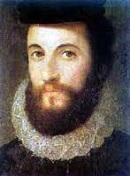



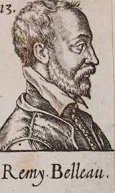

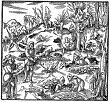
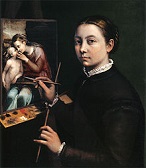
1556 On Jan. 22 Polish theology student Peter Gonesius (Piotr of Goniadz) (1525-73) gives a speech against the doctrine of the Trinity at a gen. synod of Calvinist (Reformed) churches in Secemin, Poland, causing him to be excommunicated by the Council of Pinczow in Apr. and banished from Lesser Poland, gaining protection in 1558 from Jan Kiszka (1552-92) and becoming head of the Protestant commune in Wegrow, causing a split in the Calvinist community, which Sigismund II Augustus attempts to heal with a debate called in 1565, which only hardens their division, causing the anti-Trinitarian Polish Brethren (Minor Reformed Church) to hold their own synod in Brzeziny on June 10, 1565; too bad, it is dissolved on July 20, 1658 with their expulsion from Poland, emigrating the Prussia, Transylvania, and the Netherlands. On Jan. 23 (a.m.) the 1556 Shaanxi Earthquake in Shensi (Shaanxi) Province in Ming China kills 830K, becoming the worst earthquake on record (until ?). India becomes the center of the Earth? On Jan. 27 Mughal emperor #2 (since 1530) Humayun (b. 1508) dies, and his son (grandson of Babar) Akbar (Akhbar) the Great (Jalaluddin Muhammad Akbar) (1542-1605) becomes Mughal (Mogul) emperor #3 of N India (until Oct. 27, 1605), a Muslim ruling a Buddhist nation from the city of Agra S of the Himalayas, going on to extend the empire S to the Deccan while fostering the arts, architecture, and poetry, and trying unsuccessfully to establish a syncretistic court religion bringing the different religions of India together, sponsoring open court debates between followers of all religions and encouraging free speech and expression; he sends an expedition to find the source of the Ganges River, and receives report of a paradise called Shambala (Shangri-La) (Gyanganj) N of the Himalayas. On Feb. 5 after Guise rival Anne de Montmorency (1493-1567), constable of France arranges it, Henri II of France and Philip II of Spain sign the Treaty (Truce) of Vaucelles with Spain, frustrating Guise plans in Italy. So be honest with yourself, don't try to fake romance, it's the good life to be free and explore the unknown? Maybe this is where all those jokes about women on the rag come from? On Mar. 21 despite publicly recanting Protestantism to save himself, giving her a propaganda coup, Bloody Mary goes overboard and orders Archbishop Thomas Cranmer (b. 1489) burned anyway, but he turns her propaganda coup on its ear by publicly repudiating his recantations, uttering the immortal soundbyte: "And as for the Pope, I refuse him, as Christ's enemy and Antichrist, with all his false doctrine", and then holding his right hand that had signed them exposed to the flames, letting it burn to a crisp before the flames reach his body, while repeating the words "this unworthy right hand" a holy bird flip?); on Mar. 22 Cardinal Reginald Pole (1500-58) becomes the last Roman Catholic archbishop of Canterbury and papal legate (until 1558), getting imprisoned next year by Pope Paul IV in Castel Sant'Angelo on suspicion of being a Lutheran; meanwhile the Protestant persecution in England reaches its peak in Mar., with 300+ burned at the pole. In summer after Martin Guerre (1524-) disappeared in 1548, leaving his wife Bertrande and son without a trace, a man arrives in Artigat who claims to be him, living with her for three years and having two more children until the villagers grow suspicious, getting him tried in Rieux in 1560, and after several witnesses ID him as Arnaud "Pansette" du Tilh from the nearby village of Tilh, he is convicted and sentenced to beheading, and he almost convinces the parlement of Toulouse of his innocence until the real Martin shows up complete with wooden leg from the Aug. 10, 1557 Battle of St. Quentin, after which he is hanged on Sept. 16, 1550 in front of Guerre's house. On July 14 after Queen Catherine de' Medici sends for Nostradamus (1503-66), he leaves Salon for Paris, using horses posted for him by the queen to cut the travel time from two mo. to one; he arrives on Aug. 15, and has a 2-hour audience with her on July 15, followed by a brief audience with skeptical Henri II; he spends two weeks in residence at the palace of the archbishop of Sens seeking his guidance, then returns for a 2nd audience with his fan the queen, and draws up horoscopes for her seven children using a magic mirror, assuring her that all her sons will be kings; fleeing the Justices of Paris, who suspect him of magic practices, he returns to Salon, and spends the rest of his life finishing his Centuries and casting horoscopes. On July 31 Jesuit Order (Society of Jesus) founder (St.) Ignatius of Loyola (b. 1491) dies in Rome; the order is established in Prague; by now it has about 1K members worldwide - bon appetit? On Aug. 27 after his brother Ferdinand I's work at Augsburg restores good relations, which had grown icy after he designated the imperial crown for his Valladolid-born Hapsburg son Philip II (the Prudent) (1527-98) instead of him on Jan. 16, gout-suffering HRE Charles V (Charles I of Spain) gets religion and officially abdicates at Brussels, designating Ferdinand I as king of Germany (reserving his title of HRE until 1558) and Philip II as "Most Catholic King" of Spain (until Sept. 13, 1598), although his "advice" remains a command; under Philip II Spain reaches the height of its grate wealth and powah, entering its Golden Age as "the empire on which the Sun never sets", although Spain declares bankruptcy in 1557, 1560, 1569, 1575, and 1596, allowing the Dutch Repub. to declare independence in 1581; the war with France continues; Charles V retires to a luxurious life in the monastery of Yuste N of the Tagus Valley as a private individual not a monk, with 150 attendants (who are forever busy digging up fishy delicacies for his table), giving official control of the Hapsburg lands to Ferdinand I, while Philip II gets Spain, its overseas colonies, the Spanish islands in the Mediterranean (incl. Sicily), the Italian possessions (incl. Naples, Milan), Franche-Comte, and the Netherlands, causing speculation that there will be a winner-take-all war later; daddy "advises" Philip II to be "cutting out the root of heresy with rigor and rude chastisement", causing him to order the duke of Alva to give up his attacks on the Papal States in the Italian campaign so he can go toast some Dutch butt; Philip II speaks only Spanish but now rules the Netherlands along with his 2nd wife Bloody Mary Tudor of England, and reenacts Charles V's Edict of 1550, beginning "the longest, the darkest, the bloodiest, the most important episode in the history of the religious reformation in Europe"; he appoints inquisitor-gens. who send out a dozen inquisition officers throughout the Netherlands (Peter Titelmann et al.) to arrest people and burn them at the stake for offenses incl. reading the Bible, joking as they writhe in the flames; meanwhile during his reign Spain enters its Golden Age, reaching the height of its grate wealth and powah, becoming known as "the empire on which the Sun never sets" - yes I've seen it before, just little bits of history repeating? In Sept. the duke of Alva is ordered to move against Rome to stop persecution of the pro-Spanish clique by Pope Paul IV. In fall Richard Chancellor returns from Russia with Osep (Osip) (Joseph) Nepeja (Nepeya), the first Russian ambassador to England; too bad, on Nov. 7 Chancellor dies in a wreck at Pitslago off the coast of Scotland, but the ambassador makes it to London. In Oct. Lautaro and his reduced force move N to the Mataquito River, are attacked by the Spanish, and retreat S to the Itara River, planning a sneak attack of Santiago; too bad, a traitor tips the Spanish off. In Nov. Francois de Lorraine, 2nd Duc de Guise crosses the Alps with his army and marches on Naples, but the pope reneges on promised support, causing him to be forced back but remain in Italy; meanwhile the duke of Alva marches to the outskirts of Rome. The Spanish finish conquering Venezuela. Ivan IV the Terrible conquers the Tartar khanate of Astrakhan, bringing the Volga River within Russia's borders; the last khanate, the Crimea holds out until 1783. Under the pressure of Suleyman I the Magnificent, the Transylvanian Diet recalls John II and his mother Isabel, splitting it off from Hungary again; Ferdinand I refuses to recognize them. Johan Vasa (b. 1537) (future John III of Sweden) becomes duke of Finland. Tobacco is introduced into France by Andre Thevet, a monk from Angouleme. Father Gaspar Da Cruz becomes the first Roman Catholic missionary in China; in 1560 after returning he pub. the first description of tea in Portuguese": "A drink called ch'a, which is somewhat bitter, red, and medicinal". London trader William Towerson leaves with a fleet from Plymouth for Africa, where he becomes the 2nd Englishman to bring back African slaves next year. The handwritten montly Notizie Scritte, one of the first newspapers begins pub. in Venice. Italian scholar Lodovico Castelvetro (1505-71) translates Aristotle, and begins demanding that Aristotelian principles be applied to Italian drama, getting a tight version of his Three Unities adopted; too bad, he gets caught translating Protestant texts, is labeled a heretic, and exiled next year. Architecture: Suleiman I's Mosque in Constantinople (begun 1550) is completed. Nicholas Brigham (-1558) builds Geoffrey Chaucer's Tomb in Westminster Abbey, founding Poet's Corner; next is Edmund Spenser in 1599. Art: Sophonisba Anguissola (1532-1625), Self-Portrait; in 1559 she becomes tutor to Spanish queen Elizabeth of Valois in Madrid, going on to become official court painter to Philip II, helping open the painting profession to women. Nonfiction: Georgius Agricola (Georg Bauer) (1494-1555), De Re Metallica (On the Nature of Metals); first comprehensive treatise on mineralogy, founding the study of physical geology, and used as the std. textbook for the next 250 years; by an Italian-trained physician from Saxony who settled in Joachimsthal, Bohemia in 1527 and began a lifelong study, ending up with the #1 book on mining from A-Z, incl. miners diseases; later tr. into English by U.S. pres. Herbert Hoover. Daniele Barbaro (1514-70) (tr.), Vitruvius' Ten Books of Architecture; improved trans., incl. an extensive commentary, making a fan of El Greco (Domenikos Theotokopoulos (1541-1614), who criticizes Vitruvius' technique of distorting proportions in order to compensate for distance from the eye, with the soundbyte: "I would not be happy to see a beautiful, well-proportioned woman, no matter from which point of view, however extravagant, not only lose her beauty in order to, I would say, increase in size according to the law of vision, but no longer appear beautiful, and, in fact, become monstrous." French composer Philibert Jambe de Fer, Epitome Musical, des Tons, Sons, et Accordz... Violes & Violons; contains the first mention of the violin and cello. Martin de Azpilcueta Navarrus (1493-1586), Manual on Moral Theology; first to state clearly that govt. price-fixing won't work? Poetry: Remy Belleau (1528-77), Les Petites Inventions; inspired by ancient Greek lyric poet Anacreon and launching his style of paradoxical poems of praise for simple things incl. butterflies, cherries, coral, oysters, shadows, and turtles. Music: Juan de Avila (1499-1569), Audi Filia. Orlando di Lasso (1532-94), First Book of Motets; "Motet: a contrapuntal, polyphonic unaccompanied sacred song". Births: German musical historian, composer, chronologer-astronomer Sethus Calvisius (Setho Calvisio) (Seth Kalwitz) (d. 1615) on Feb. 21 in Gorsleben, Thuringia. English poet-dramatist George Peele (d. 1596) on July 22; baptized on July 25. Spanish priest (founder of the Piarists) (St.) Joseph Calasanctius (Calasanz) (d. 1648) on Sept. 11 in Calasanza Castle (near Petralta de la Sal), Aragon; feast day: Aug. 27. French cardinal-theologian-diplomat Jacques Davy Duperron (d. 1618) on Nov. 15 (Nov. 25 Old Style) in St-Lo, Normandy; born of Calvinist parents, he studies St. Augustine and St. Thomas Aquinas and converts to Roman Catholicism in 1577-8, then is created cardinal in 1604 after defeating Calvinists in a public debate and becoming their poster boy. French architect Jacques II Androuet du Cerceau (d. 1614). English miniature painter Isaac Oliver (Olivier) (d. 1617) (1565?) in Rouen, France; French Huguenot parents; emigrates to England in 1568; husband of the daughter of Marcus Gheeraerts the Elder; father of Peter Oliver. Dutch Later Mannerist sculptor Adriaen de Vries (d. 1626) in The Hague. Italian-Swiss Baroque architect Carlo Maderno (Maderna) (d. 1629) in Capolago (modern-day Ticino, Switzerland); brother of Stefano Maderno (1576-1636)? Deaths: Italian-born Russian Greek Orthodox monk Maxim Grek (b. 1470). English Protestant archbishop of Canterbury (1533-55) Thomas Cranmer (b. 1489) on Mar. 21 (burned at the stake); the Catholics spread rumors that he kept his 2nd wife Margaret concealed in a box when traveling, with the soundbyte "He kept his woman very close, and sometimes carried her about with him in a great chest full of holes, that his pretty nobsey might take breath at." Italian painter Lorenzo Lotto (b. 1480). German composer Martin Agricola (b. 1486) on June 10 in Magdeburg. Spanish mystic and Jesuit Order founder Ignatius Loyola (b. 1491) on July 31 in Rome. Italian author Pietro Aretino (b. 1492) on Oct. 21; "He is said to have died of suffocation from laughing too much". Italian painter Pontormo (b. 1494). Italian poet Luigi Alamanni (b. 1495) on Apr. 18 in Amboise. English merchant-financier Sir John Gresham (b. 1495) on Oct. 23. Dutch Anabaptist leader David Joris (b. 1501) in Basel; wrote 200+ works; since 1544 lived under the alias of Jan van Brugge, pretending to be a member of the Reformed Church; in 1559 he is found out, his remains exhumed and burned by church officials for heresy. English author-dramatist Nicholas Udall (b. 1504). Indian Mughal emperor #2 (1530-40) Humayun (b. 1508) on Feb. 22 (Old Style) in Delhi. Spanish conquistador Domingo Martinez de Irala (b. 1509) in Paraguay. Ottoman Persian-Turkish poet Mehmed Fuzuli (b. ?); leaves the poem Leyl and Majnum on Platonic love.



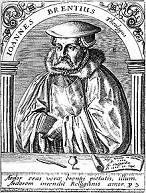

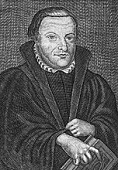
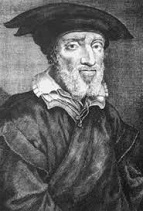

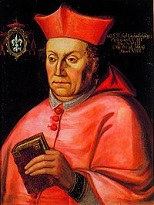
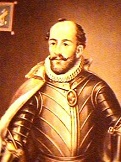






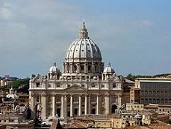
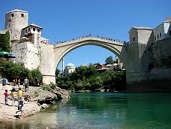
1557 This year there is an influenza epidemic throughout Europe. The Double Default of 1557 sees the Spanish and the French default on their debts. On Mar. 30 Andres Hurtado de Mendoza (Andrés Hurtado de Mendoza, 3rd Marquis of Cañete) (1495-61) becomes viceroy #5 of Peru (until Mar. 30, 1561), finally establishing Spanish authority, while his son Garcia Hurtado de Mendoza (1535-1609) resumes the Spanish conquest of Chile, with special permission to enslave rebel Indians, and goes after Lautaro. You're a carousel, you're a wishing well? In Mar. Philip II returns to England, gives Queen Mary a "second honeymoon", and persuades her to enter the war against pesky France; he also tries unsuccessfully to persuade Princess Elizabeth to marry his protege Duke Emmanuel Philibert of Savoy; in July Philip II leaves England and Queen Mary forever, hoping to return after his Spanish Armada kicks Protestant butt; meanwhile an English messenger is sent to France to deliver a declaration of war to Henry II. On Apr. 29 the Spanish stage a surprise attack on Lautaro (b. 1534) from the Caune Hills and kill him. Oh the games people play now, every night and every day now? In May Anne de Montmorency, constable of France orders the duke of Guise to leave Italy and return to France to face the Spanish buildup in the Netherlands, but he procrastinates in hopes of beating the duke of Alva. On June 11 king (since 1521) Joao III the Pious (b. 1502) dies, and his 3-y.-o. grandson Sebastian (Sabastiao) I (the Desired) (1554-78), son of Prince John Manuel and Joanna of Austria, and grandson of John III and HRE Charles V becomes Avis king #16 (next-to-last) of Portugal (until Aug. 4, 1578) - at least the port's still good? You say poh-tay-toe, I say poh-tah-toe, let's call the whole thing off? On Aug. 10- (Feast of St. Lawrence)-Aug. 27 the Battle of St. Quentin (Saint-Quentin) sees Saint-Quentin in Picardy taken from the French by a 60K-80K-man Spanish Hapbsburg army under the duke of Alva supported by Mary I's English under Duke Emmanuel Philibert of Savoy, becoming a costly D for ambitious Valois king Charles V, who loses 3K KIA, 14K-15K injured, and 7K taken POW; Constable Anne of Montmorency is taken POW; "The sight of the battlefield gave Philip a permanent distaste for war", withdrawing to the Spanish Netherlands; both the Spanish and French crowns declare bankruptcy; too late, in Oct. the duke of Guise rushes back to France and is appointed lt-gen. On Sept. 11-Oct. 8 the Colloquy of Worms between Protestant Lutheran theologians Philip Melanchthon (1497-1560), Johannes (Johann) Brenz (1499-1570), Theodore Beza (1519-1605), and Erhard Schnepf (1495-1558), and Roman Catholic theologians Michael Helding (1506-61) (AKA Sidonius), Jesuit (St.) Peter Canisius (1521-97), and Johannes (Johann) (John) Gropper (1503-59) (who started out as a follower of Erasmus then couldn't give up the security of the Church and the problem that if God meant Christians to be Protestants, why did he let the Church run things all this time), the last imperial conference of the cent. starts out with the Catholics questioning the Bible as the only source of authority, and ends when they bring up the Protestants' dirty laundry of disagreements among themselves about basic doctrines of original sin and justification based on Bible reading; Beza suggests that all Protestant sects unite, and is told to fork off by Zurich and Bern, causing him to settle in Geneva next year. On Sept. 27 emperor (since 1526) Go-Nara (b. 1497) dies, and on Oct. 27 his eldest son Ogimachi (1517-93) (personal name Michihito) becomes Japanese Yamato emperor #106 (until Dec. 17, 1586). In Dec. the First Covenant (Congregation of the Lord) is signed in Scotland, creating the Protestant Lords of the Congregation (Faithful Congregtion of Christ Jesus in Scotland), pledged to maintain Presbyterian as Scotland's sole religion and later establishing the supremacy of Parliament over the crown in Scotland, becoming the "First Blast of the Trumpet". After agreeing to pay 550 taels/year of silver (1 tael = 41.6 lbs.), the Portuguese colonize the Chinese seaport of Macau (Macao), which they hold until 1999. The Ottomans capture the ports of Suakin and Massawa (Mitsiwa, Batsi) on the African shores of the Red Sea, allowing them to resume trade through Egypt; they found the province of Habesh (Abyssinia), governed from Massawa. The Burmese destroy the N Thai state of Chiengmai (Chiang Mai) after it is weakened by Siam. The Spanish begin mining silver in Potosi (Potosí), Bolivia at the foot of Cerro Rico (Sp. "rich mountain"), becoming Spain's major silver supply. The title of surgeon is first recorded in the British navy. The Stationers' Co. of London (founded 1403) is granted a royal charter with a printing monopoly in England. Gonville College in Cambridge (founded in 1348 by Edmund Gonville) is refounded as Gonville and Caius College by John Caius (Kays) (1510-73) (pr. like keys), royal physician to Edward VI, Mary I, and Elizabeth I. Repton School for boys is founded in Derbyshire, England. Architecture: After succeeding Antonio da Sangallo the Younger as the architect of St. Peter's Basilica (begun Apr. 18, 1506) in 1547, and transforming the plan to finish the W end and dome to his design, Michelangelo gets pissed-off at his builders when a portion of it has to be dismantled and redone because of an erroneous calculation, writing that it's all their fault, "As the model, such as I make for everything, was exact"; it is not completed until Nov. 18, 1626. The Stari Most (Old Bridge) in Mostar ("bridgekeeper"), Herzegovina over the Neretva River is begun by Suleiman the Magnificent; it is finished in 1567; too bad, on Nov. 9, 1993 it is destroyed during the Bosnia-Herzegovina War, and reopens on July 23, 2004. Inventions: Sevillean merchant Bartolome de Medina invents the Patio Ore Reduction Process for the rich silver mines of Pachuca in Hidalgo, Mexico (55 mi. NE of Mexico City), which were worked before the Spanish conquest. Inventions: French Huguenot potter Bernard Palissy (1510-89) invents Enamel after 16 years spent trying to imitate Chinese porcelain, causing imitators to begin cranking out Palissy Ware, featuring molds of real creatures incl. fish and crabs. Science: The one year that English math and poetry go hand-in-hand? Italian scholar-physician Julius Caesar Scaliger (1484-1558) discovers the metallic element Platinum (pt) (#78) Jean Pena, royal mathematician at Paris rejects the spheres of fire and of the planets after determining by optical reasoning that some comets are beyond the Moon. Nonfiction: Robert Recorde (1510-58), The Whetstone of Witte; introduces the = (equals) symbol into mathematics. Julius Caesar Scaliger (1484-1558), Exercitationum Exotericarum Liber XV de Subtilitate ad Hieronymum Cardanum - dirty deeds done dirt what? Hans Staden, The New World; titillates Euros with depictions of cannibalism by the Tupinamba (Tupinambá) tribe of Brazil. Thomas Tusser, A Hundreth Good Pointes of Husbandrie. William Whittingham (1524-79), Myles Coverdale (1488-1569) et al., The Geneva Bible (London) (1557-60); an inexpensive portable English Bible with extensive Calvinist-slanted "annotations upon all the hard places" (marginal glosses), which piss-off Anglican prelates, who associate it with Presbyterians, who wish to abolish the Episcopalian form of govt. by bishops and replace it with govt. by lay elders; it's also furnished with instructional aids, becoming the first study Bible, and the first using verse numbering by Robert Estienne (Stephanus) of Paris; dedicated to Queen Elizabeth I, it is often used and/or quoted by John Knox, John Bunyan, John Donne, Oliver Cromwell, and Shakespeare, and later preferred by Puritans over the King James Bible, dissing the divine right of kings and always translating the word king as tyrant, causing Charles I to ban it in 1644, leading to Puritan takeover of the govt. and his beheading, even though they later realize the superiority of the 1611 KJV. Plays: ?, The Sack-Full of Newes; first English play to be censored? Poetry: Sir Thomas Wyatt (1503-42), Certain Bokes of Virgiles Aenaeis turned into English Meter; tr. of books 2-3 of Vergil's "Aeneid" in blank verse of five iambic feet, becoming the first use of this form in English. Richard Tottel (-1594) (ed.), Songs and Sonnets written by the Ryght Honorable Lorde Henry Howard late Earle of Surrey, and Other (Tottel's Miscellany); the first anthology of English poetry, and the first pub. of the poetry of Sir Thomas Wyatt (1503-42) and Henry Howard, Earl of Surrey (1517-47), introducing the English 14-line sonnet (based on Italian models); Wyatt uses the Italian or Petrarchan sonnet form (abba, abba, cdc, dee), while Howard invents the English or Shakespearean form of three quatrains (abab, cdcd, efef) and a couplet (gg); later Sir Edmund Spencer invents his own form (abab, bcbc, cdcd, ee). Births: Transylvanian prince (1604-6) Stephen Bocskai (Istvan Bocskay) (d. 1606) on Jan. 1 in Kolozsvar (Cluj-Napoca). Bohemian Hapsburg king (1611-9) and HRE (1612-9) Matthias (d. 1619) on Feb. 24 in Vienna; son of HRE Maximilian II (1527-76) and Maria of Spain (1526-1603); husband of archduchess Anna of Austria. Russian tsar (1584-98) Fyodor (Theodore) ("divine gift") I (the Bellringer) (d. 1598) on May 31 in Moscow; son of Ivan IV the Terrible (1530-84). English soldier (martyr) Philip Howard, 20th (13th) Earl of Arundel (d. 1595) on June 28 in Strand, London; eldest son of Thomas Howard, 4th duke of Norfolk (1536-72) and Lady Mary FitzAlan; first Howard to become an earl of Arundel. Italian painter Agostino Carracci (Caracci) (d. 1602) on Aug. 16 in Bologna; father of Antonio Marziale Carracci (1583-1618). English poet Thomas Watson (d. 1592) in London; educated at Winchester College, and Oxford U. English composer-theorist Thomas Morley (d. 1603). Italian Venetian School composer Giovanni Gabrielli (Gabrieli) (d. 1612) in Venice; son of Andrea Gabrieli (1520-86). Deaths: Italian-born English historian Polydore Virgil (b. 1470) in Urbino, Italy. Italian explorer Sebastian Cabot (b. 1476) in Dec. Spanish historian Gonzalo Fernandez de Oviedo y Valdes (b. 1478); leaves Las Quinquagenas de la Nobleza de Espana, a collection of anecdotes about contemporaries, pub. in 1880. Italian author Giovanni Francesco Straparola (b. 1480). Italian geographer Giambattista Ramusio (b. 1485) on July 10 in Padua. Spanish cardinal Juan Alvarez de Toledo (b. 1488) on Sept. 15. Scottish stud Archibald Douglas, 6th earl of Angus (b. 1489). Spanish conquistador Alvar Nunez Cabeza de Vaca (b. 1490). French explorer Jacques Cartier (b. 1491) on Sept. 1 in St. Malo. Italian scholar Niccolo Tartaglia (b. 1500) on Dec. 13. Portuguese king (1521-57) Joao III the Pious (b. 1502) on June 11 in Ribeira Palace, Lisbon. Italian condottiero Ferrante I Gonzaga (b. 1507) on Nov. 15 near Brussels; dies after falling from his horse from fatigue after the Battle of St. Quentin. Lutheran theologian (bishop of Turku) Michael Agricola (b. 1510) on Apr. 9; dies on a return trip from Moscow to arbitrate boundary disputes between Russia and Sweden. English Greek scholar Sir John Cheke (b. 1514) on Sept. 13 in London. German-born English queen (1540) Anne of Cleves (b. 1515) on July 16 in Hever, Kent. German margrave of Brandenburg-Kulmbach (1527-53) Albert II Alcibiades (b. 1522) on Jan. 8 in Pforzheim; dies during a campaign to regain his lands; gains the cognomen Alcibiades posth.; "A failure of a Fritz", with "features" of Frederick the Great, "but who burnt away his splendid qualities as a mere temporary shrine for the able editors, and never came to anything, full of fire, too much of it wildfire, not in the least like an Alcibiades except in the change of fortune he underwent" (Thomas Carlyle). Chilean rebel leader Lautaro (b. 1534) on Apr. 30 in Maule. Scottish Protestant theologian John MacAlpine (Maccabeus) (b. ?) on Dec. 6 in Cophenhagen, Denmark; trans. Martin Luther's German Bible into Dutch.







1558 On Jan. 7 the duke of Guise captures Calais from the English, leaving them with ixnay in France - time to put on your thinking cap with the row of nuts and bolts? On Feb. 2 the U. of Jena in Thuringia is chartered by HRE Ferdinand I after deceased Saxon elector John Frederick I the Magnanimous (who originally wanted to put it in Wittenberg) planned it out during his imprisonment and his three sons carry out his will; it goes on to produce German brain men Gottlieb Fichte, Georg Wilhelm Friedrich Hegel, Friedrich Schelling, and Friedrich Schiller; it is renamed for Schiller in 1934. In Mar. HRE Charles V (b. 1500) formally abdicates at the Monastery of Yuste in Spain, then dies on Sept. 21; he recognizes his illegitimate son Don Juan of Austria (b. 1547) in his will, and entrusts him to the care of Philip II, who grants him the rank of a prince of the House of Austria with a residence in Madrid next year; on Mar. 15 handsome goateed Ferdinand I (1503-64) is crowned HRE in Frankfurt (until July 25, 1564), working to effect a Roman Catholic-Protestant reunion, which ultimately flops because of his insistence that bishops retain their secular authority. On Apr. 11 15-y.-o. Mary Stuart, Queen of Scots (niece of the Duke of Guise) is formally betrothed to 14-y.-o. dauphin Francis II (b. 1544), son of Henry II of France, her childhood playmate, causing public rejoicing in Paris; the official marriage contract reaffirms the Auld Alliance, incl. dual nationality for Scots and French; if Mary dies the succession is given to the Earl of Arran, but by a secret treaty signed by the ditzy teen queen, if she dies without issue it goes to Francis, which is later found out, pissing-off the Scottish parliament; on Apr. 24 they are married at Notre Dame Cathedral, where she becomes the first bride to have a white wedding (the color of mourning); at the urging of Henry II, Mary quarters the arms of England in her new coat of arms; half of the Scottish commissioners die on the way back to Scotland; meanwhile Sir William Maitland of Lethington (1525-73) becomes Scottish secy. of state to queen regent Mary of Guise. On May 11 after Ivan the Terrible defeats the Livonian Knights (Brothers of the Sword), who place Livonia under Lithuanian protection, after which Poland, Russia, Sweden, and Denmark get in a dispute over succession and territory, starting the Livonian War (ends 1583); the Swedes take Estonia, and the Danes take part of Courland; Narva in modern-day Estonia is captured by the Russians, causing Ivangorod to become the main Russian seaport on the Baltic coast; Tartu in Estonia (pop. 6K) surrenders without a fight, and the bishop is imprisoned in Moscow, ending the bishopric in Estonia and adjacent states. On June 27 Nostradamus signs an Epistle to Henry II, which is used as the preface to the 3rd enlarged ed. of his "Centuries" (300 more quatrains), pub. in 1568. On July 13 the Spanish under the duke of Alva defeat the French at the Battle of Gravelines near Calais, causing them to finally cry oncle? One of the biggest turning points in history: The Red Queen is followed by a White Queen? On Nov. 17 (7:00 a.m.) after learning of the loss of Calais, English queen (since July 1553) Bloody Mary I Tudor (b. 1516) dies childless (she had a tumor not a child) (but just in case she's got a bun in the 42-y.-o. oven she leaves her child the throne in her will?), and after holding out until 10 days before her death to name her as heir, is succeeded by her witch-lucky Protestant half-sister Elizabeth I (1533-1603) (until Mar. 24, 1603) (last Tudor monarch); English Roman Catholics forever consider her to be an illegitimate bastard, while English Protestants forever consider her to be their Virgin Mother, saving them from becoming toast; she becomes the 3rd child of Henry VIII who considers it their right to dictate the religion of the nat. church; she promptly swings it back to Protestant, but calls it the "Middle Path" of Protestant doctrines and Roman Catholic ceremonies, robes, and trappings to please the crowd (a Catholic Protestantism?); at her coronation a ring is placed on the 4th finger of her right hand to symbolize her mystical marriage with her people; the exhilarating golden Elizabethan Age (Era) is launched (ends 1603), marked by nat. cultural renaissance, internat. expansion, and naval triumph; her minister Sir William Cecil soon manipulates her to get extreme Protestantism back with a vengeance; after defending his Roman Catholic beliefs, cardinal (since Aug. 7, 1587) William Allen (1532-94) is forced into exile, founding a seminary in the Spanish Netherlands to provide priests for the English; on Nov. 17 (7:00 p.m.) Cardinal Reginald Pole (b. 1500), archbishop of Canterbury since 1556 dies in London - Anglicanism = Roman Catholic Protestantism? The English Immaculate Conception? On Nov. 20 at Hatfield Elizabeth I names male supremacist Sir William Cecil (1520-98) (pr. SEHS-ul) (Baron Burleigh in 1571) as secy. of state (he thinks a woman can't run the country, but she proves him wrong?), and Sir Nicholas Bacon (1510-79) (later the foster father of Sir Francis Bacon) as lord keeper of the Great Seal (lord privy seal). On Nov. 23 Elizabeth I leaves Hatfield with 1K courtiers and travels trimphantly through Hertfordshire and Middlexex to London for her official reception; at the city walls of London she is greeted amid cheering throngs by the Lord Mayor, but snubs Edmund "Bloody" Bonner, bishop of London, who had been responsible for Mary's burning of Protestants, and after he refuses to take the oath of supremacy removes him from office and locks him in the Tower until death (1569); she moves into royal apts. in the Tower of London on Nov. 28, pausing to express gratitude for not being executed there earlier; on Dec. 23 she moves to Whitehall Palace, her favorite residence. On Dec. 13 the Battle of Quiapo in Arauco Province, Chile is another V for 200 Spaniards under Garcia Hurtado de Mendoza over 7K-8K Mapuchi under chief (toqui) Lemucaguin or Caupolican (Caupolicán) the Younger. On Dec. 14 Queen Mary is buried in Westminster Abbey with traditional Roman Catholic ritual - did they burn incense? On Dec. 25 Elizabeth I celebrates Christmas Mass in her chapel in Whitehall Palace; as no Roman Catholic bishop will help her, Bishop of Carlile (since 1557) Owen Oglethorpe (-1559) celebrates it, but when he begins elevating the host, Elizabeth orders him to desist, and when he refuses, walks out? On Dec. 27 Elizabeth I issues a proclamation declaring that parts of the Mass may be said in English rather than Latin, and forbidding all preaching until further notice. After the accession of Elizabeth I, Puritanism, a movement inside the Anglican Church that disses all Roman Catholic trappings esp. ritual and ceremony has its beginnings in England. 90-y.-o. imperial adm. Andrea Dora begins fighting the French in Corsica (until 1560). Philip II sends Don Gomez Suarez de Figueroa, Count de Feria to England as Spanish ambassador, exploring a possible marriage proposal to Elizabeth; meanwhile Philip II's mistreatment of the Netherlands reaches a head, causing them to go into revolt. Thomas Gresham calls for a reform of English currency after noting that Henry VIII's debasement of it has lowered its value in relation to the currency of other countries, formulating Gresham's Law that "bad money drives out good"; the queen knights him for it next year. Tobacco is brought from America to Spain for cultivation for the first time by physician Francisco Fernandes after being sent by Philip II to report on its products; the Portuguese soon introduce the delights of snuff to Europe. Anthony Jenkinson travels to Bokhara. Italian sculptor Benvenuto Cellini (1500-71) becomes a Roman Catholic priest (should we say a crafty priest?), despite having a mistress (Piera) and two children (Constanza, Jacopo Giovanni), plus another which died during infancy; he is released from his vows in 1560 to marry her, and go on to have more children (Giovanni, Elisabetta, Lipterata) before getting legally married in 1564. The Hamburg Stock Exchange in Germany is founded. Architecture: Suleymaniye Mosque (begun 1550) is finished; Sultan Suleiman the Magnificent and his wife Roxelana are later buried in the cemetery behind it in tombs built by Mimar Sinan. Nonfiction: John Knox (1505-72), The First Blaste of the Trumpet Against the Monstrous Regiment of Women (Geneva); quotes the Bible to diss govt. by women; directed chiefly against Mary of Guise and her daughter Mary Stuart, Queen of Scots, but even Elizabeth is implied?; "I am assured that God hath revealed to some in this our age that it is more than a monster in nature that a woman should reign and bear empire over man" - God gave men testicles for a reason? Giambattista della Porta (1535-1615), Magia Naturalis (Natural Magic) (20 vols.) (1558-70); "Wherein are set forth all the riches and delights of the Natural Sciences"; explains the difference between magical and physical events such as magnetism, and shows how to put a convex lens inside the aperture of a camera obscura to brighten the projected image, making it more popular. Gioseffo Zarlino (1517-90), Institutioni Harmoniche; defines most major and minor musical scales. The 13th cent. Qabbalistic work Zohar is printed. Art: Pieter Brueghel the Elder (1522-69), Children's Games. Titian (1477-1576), Diana and Actaeon; Europa on the Bull; Actaeon Torn to Pieces by His Dogs. Daniele da Voltera, Massacre of the Innocents. Poetry: Margaret of Navarre (1492-1549), Heptameron des Nouvelles (posth.). Births: English "The Spanish Tragedy", "Edward III" dramatist Thomas Kyd (d. 1594) on Nov. 3 in London; baptized on Nov. 6. English poet-dramatist-pamphleteer Robert Greene (d. 1592) in Norwich; educated at St. John's College, Cambridge U. - our house, just one sip and you'll be sold? English dramatist George Peele (d. 1598). Wallachian prince Michael the Brave (d. 1601). English Gunpowder Plotter Thomas Percy (d. 1605); educated at Cambridge U. Italian composer Giovanni Gabrieli (d. 1613). English poet-dramatist Thomas Lodge (d. 1625) in West Ham, Lincolnshire; educated at Trinity College, Oxford U. Dutch explorer Olivier van Noort (d. 1627) in Utrecht. Japanese artist (founder of the Rinpa School) Hon'ami Koetsu (d. 1637). Deaths: Italian scholar Julius Caesar Scaliger (b. 1484) on Oct. 21 in Agen, France. German Protestant leader Johannes Bugenhagen (Doktor Pomeranus) (b. 1485) on Apr. 20 in Wittenberg, Saxony. Portuguese poet Francisco de Sade Miranda (b. 1485); leaves the plays Comedia dos Estrangeiros, Comedia dos Vilhapandos, and Cleopatra. German Lutheran theologian Erhard Schnepf (b. 1495) on Nov. 1 in Jena. French physician Jean Francois Fernel (b. 1497) in Fontainebeleau. Spanish king (1516-56) and HRE (1519-56) Charles V (b. 1500) on Sept. 21 in Yuste, Spain. English archbishop of Canterbury (1556-8) cardinal Reginald Pole (b. 1500) on Nov. 17 in London. English ambassador Sir Philip Hoby (b. 1505) on May 31 in Blackfriars, London. English mathematician Robert Recorde (b. 1510). English queen (1553-8) "Bloody" Mary I Tudor (b. 1516) on Nov. 17 in St. James's Palace, London; buried in Westminster Abbey on Dec. 14. English scholar Nicholas Brigham (b. ?).




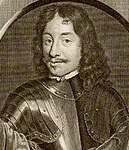








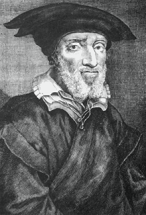






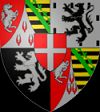
1559 On Jan. 1 Christian III (b. 1503) dies, and after Christian II (b. 1481) obligingly dies on Jan. 25, Christian III's son Frederick II (1534-88) succeeds him as king of Denmark and Norway (until Apr. 5, 1588), going on to become a typical Euro Renaissance monarch who likes to play soldier. The original L.A. woman? On Jan. 15 to large cheering crowds "Virgin Queen" Elizabeth I (1533-1603) is crowned queen of England in Westminster Abbey (until Mar. 24, 1603) (the 43rd British monarch), the last of the Tudor Dynasty, immediately reverting to Protestantism; at the coronation a ring is placed on the 4th finger of her left (right?) hand to symbolize her mystical marriage with her people; her childhood friend Sir Robert Dudley (1533-88) becomes master of the horse (the original Italian Stallion?), riding immediately behind her in procession, and becomes her favorite, causing marriage rumors to spread; on Jan. 15 Henry II of France publicly declares her a bastard unfit to be queen of England, and proclaims his daughter-in-law Mary Stuart (the French spelling of Stewart), Queen of Scots (great-niece of Henry VIII) as the true queen; Miles Coverdale returns to England; the exhilarating Elizabethan Age (Era) is launched (ends 1603), marked by nat. cultural renaissance, internat. expansion, and naval triumph; her minister Sir William Cecil soon manipulates her to get extreme Protestantism back with a vengeance. In Jan. Elizabeth I's First Parliament (with a Protestant majority) meets, and on Feb. 9 it debates a Commons bill to restore royal supremacy over the Church of England, but throws it out, and on Mar. 18 an amended bill calling the queen the Supreme Governor (instead of Supreme Head, which St. Paul says no woman is "suffered" to be in 1 Tim. 2:12) passes the Commons, causing grumbling among clergy and laity that leads to the Elizabethan Puritan Movement, which starts out underground and begins agitating in Parliament, becoming a serious threat to the state. On Feb. 15 Pope Paul IV issues the bull Cum ex Apostolatus Officio ("By virtue of the apostolic office"), proclaiming that only Roman Catholics can be elected pope, and that all rulers who maintain heretical doctrines may be deposed by the faithful - a clear signal to English Catholics? On Feb. 20 Count von Helfenstein, sent by HRE Ferdinand I arrives in England to explore a marriage between Elizabeth I and one of the emperor's two young sons, archdukes Ferdinand and Charles. On Apr. 3 Henry II of France makes peace with England and Spain by the Treaty (Peace) of Chateau-Cambresis (Chateau-Cambrésis), ending the Italian Wars and the Hapsburg-Valois catfight, and granting a V to Spain after 60 years of war, recognizing Spanish hegemony over Italy and Franche-Comte, and rectifying France's border with the Spanish Netherlands; England confirms French possession of Calais for the next eight years, after which it's supposed to be ceded back to England; France returns Savoy to Duke Emmanuel Philibert, victor of St. Quentin, who marries Henri II's Margaret of France, Duchess of Berry (1523-74) and does away with the Austrian and French factions, restores prosperity, proclaims a cool Savoy Coat of Arms, and works to regain more territory from the French and Spanish, esp. Turin; Henry II's support for the claim of his daughter-in-law Mary Stuart, queen of Scots to the throne of England is temporarily halted. On Apr. 23 (St. George's Day) Elizabeth I bestows the Order of the Garter on her beau Robert Dudley, along with the three senior peers of the realm, the duke of Norfolk (his rival), the marquess of Northampton, and the earl of Rutland, which only makes them jealous of this son and grandson of upstart traitors who's good at riding mares? On Apr. 29 Parliament passes the stringent First Act of Supremacy and Uniformity (2nd in 1662), making Protestantism the official religion of England, reinforcing the Book of Common Prayer, and making failure to attend church each Sunday a stiff 12-pence fine; 14 bishops are dismissed from their seas, leaving only the bishop of Llandaff in office; the Book of Common Prayer is revised again, and the Black Rubric disappears from the new Elizabethan Anglican Prayer Book, which is pub. in English and Latin, but not Gaelic, although the Bible is trans. into Welsh as a concession to her own Welsh roots; De Heretico Comburendo is repealed, hopefully for the last time; Edmund Grindal (1519-83) returns to London and succeeds Edmund "Bloody" Bonner as Anglican bishop of London; on Aug. 1 Cambridge U. vice-chancellor (favorite chaplain of Elizabeth I's mother Anne Boleyn) Matthew "Nosey" Parker (1504-75) (known for trying to dig up evidence that the English church was founded independently of the Roman) is elected archbishop of Canterbury, defending the church against encroachments by the crown; meanwhile, since only the bishop of Llandaff has not been dismissed over the Act of Uniformity, and he refuses to consecrate Parker, it takes until Dec. 19 for his coronation at Lambeth by ex-bishops William Barlow, John Scory, Miles Coverdale, and John Hodgkins, causing the Jesuits to later (1604) spread the Nag's Head Fable that he was consecrated in a tavern - with the Bible open at page 1? Come on in, the coast is clear? In Apr. after the Geneva congregation of English Protestant refugees returns to England, John Knox (1505-72), having pub. A Brief Exhortation to England (anti-Mary-Stuart propaganda), sails for Scotland, where he is ordained as a minister in the Kirk of Scotland at St. Giles Cathedral (High Kirk) in Edinburgh (until 1572), and soon wins Perth and St. Andrews to his cause; his Sermon at Perth starts the Protestant Reformation going in Scotland, and he founds the first Calvinist Presbyterian (Scottish Reformed) Church (Kirk), inciting the Protestant Lords of the Congregation to religious violence, with St. Giles as the nerve center of the ruckus for the next 130 years (until 1690); Mary of Guise is deposed as regent for encouraging the French fortification of her HQ at Leith Harbor across the Firth of Forth from Edinburgh, causing it to be seiged by the Protestants. In May Sir Nicholas Throckmorton (1515-71), who narrowly escaped conviction over Wyatt's Rebellion in 1554 and escaped to France, then was pardoned in 1557 becomes English ambassador to France (until Apr. 1564), playing both sides with Queen Mary and Princess Elizabeth, secretly aiding the Huguenots. On July 10 Henry II (b. 1519) dies after a freak jousting accident on June 30 with the Count of Montgomery, capt. of the Scottish Guard leaves a large wooden splinter from a lance lodged in his eye and brain during the festivities of the marriage of Philip II of Spain (his 3rd) to his daughter Princess Elisabeth (Elizabeth) of Valois (childhood friend of Mary, Queen of Scots, who grows up to become a top scholar), who was originally betrothed to Philip II's son Prince Don Carlos de Austria but switched as a result of the Treaty of Chateau-Cambresis; the Duke of Savoy also marries Henry II's sister; on his deathbed he repeatedly calls out for his mistress (since 1534) Diane de Poitiers (1499-1566), who is blocked by Queen Catherine de' Medici, causing her to slink off into obscurity; in Sept. sickly airhead Francis (Francois) II (1544-60) is crowned Valois king #11 of France in Rheims (until Dec. 5, 1560), making his dummy corporation wife Mary Stuart, Queen of Scots also queen of France; Catherine de' Medici becomes queen mother to the next three French kings; Mary Stuart also claims the throne of England through her grandmother Margaret Tudor, citing Elizabeth's alleged illegitimacy; jousting is discontinued in France; although both France and Scotland are swarming with pesky Calvinists, Francis II prefers to go hunting, while Mary's mother Mary de Guise is facing civil war in Scotland; Nostradamus' Century I, Quatrain 35 is rumored to have predicted Henry II's death, causing him to lie low and not pub. any more; Gaspard de Coligny resigns as adm. of the French fleet to join up with the Calvinists. On Aug. 15 after a Spanish treasure ship wrecks on Padre Island in 1554, causing New Spain viceroy Luis de Velasco to want a new settlement on the N Gulf Coast to protect shipping and rescue castaways, Tristan (Tristán) de Luna y Arellano (1519-71) lands at Pensacola Bay (westernmost point in the Fla. panhandle) with 1.4K people on 11 ships and founds a colony, becoming the first Euro settlement in the continental U.S.; too bad, nobody told them, a hurricane hits on Sept. 19, killing 200, sinking five ships, and destroying most of their ships and supplies, after which they sail up the Alabama River to an abandoned Indian village - and wait for Godzilla? On Aug. 18 Pope (since 1555) Paul IV (b. 1476), Father of the Roman Inquisition dies, and on Sept. 5 a papal conclave meets; on on Dec. 25 Milan-born lawyer (cardinal since 1549) Giovanni Angelo d'Medici is elected Pope (#224) Pius IV (1499-1565), immediately reversing some of the policies of his unpopular predecessor, esp. papal hostility to Spain, and reaching out to Philip II of France and HRE Ferdinand I, whom he officially recognizes - come on, say pucker? On Aug. 28 after leading the war in Fife, Scotland in Jan., causing reports that the Scottish rebels wish to make him king, the James Hamilton, 3rd Earl of Arran (1532-1609) secretly visits London, and on Aug. 29 meets with Elizabeth I at Hampton Court, then on Aug. 31 leaves with Thomas Randolph for Scotland to lead the rebel Protestant lords of the congregation against the govt. of queen regent Mary of Guise; her secy. of state Sir William Maitland joins them and goes on a mission to Elizabeth I to negotiate a union between the two countries; Elizabeth is not impressed with Arran enough to let him pursue a marriage alliance, and he later goes insane - blame it on papa roach? In Aug. HRE Philip II withdraws from the BBQ-basting Netherlands after appointing his able half-sister (Charles V's illegitimate daughter) Duchess Margaret of Parma (1522-86) as the Hapsburg gov. (regent) #3 of the Netherlands (until 1567), but gives her nominal authority so he can deal with the revolt himself; longtime imperial statesman (secy. of state since 1550) Antoine Perrenot de Granvelle (1517-86), bishop of Arras is appointed as her PM, going on to repress the pesky Dutch Protestants so cruelly over the next five years that he is elevated to archbishop and cardinal in 1561 before beating a hasty retreat in 1564. In Oct. the Duke of Savoy and his new bride visit Nostradamus in Salon. Suleyman's Selim defeats his brother Bayezid near Konya, causing Selim to be appointed royal heir; Bayezid flees to Persia and is executed at Suleyman's request - they're all bastards anyway? HRE Ferdinand I reorganizes the Aulic Council, and reforms the German monetary system. Philip II of Spain establishes the Roman Catholic U. of Douai (Douay) in Douai, N France; lectures begin in 1562; it goes on to become the 2nd largest univ. in France in the late 17th and 18th cents., becoming a main center of neo-Latin lit. along with math and physics esp. ballistics; it is closed in 1795-1808; in 1887 it is transferred 27 km. away, becoming the U. of Lille. The first French Protestant Nat. Huguenot Synod is held in Paris, attended by reps. of 15 churches, producing the Calvinistic French Confession; two years later 2K+ churches send reps. Spanish Capt. Pedro de Urzua (-1561) leads an expedition of Spanish soldiers from coastal Peru across the Andes to the Amazon Basin in search of El Dorado and its fabled goodly bricks of gold (ends 1561). Swiss naturalist Konrad von Gesner returns to Germany with tulip seeds from Turkey, and soon tulip growing becomes a W Europe fad. That program you wanted to see is on PBS tonight NOT? "The Church has always fulfilled its duty to keep books under surveillance, but until the invention of printing, it did not feel the need to compile a catalog of prohibited books because those writings considered dangerous were burned" (Enciclopedia Cattolica); now that the Devil's invention of the printing press is running amok, threatening the status quo, Pope Paul IV pub. the first Index Autorum et Librorum Prohibitorum AKA the infamous Index of Forbidden Books, used to retard any and every religious, scientific, social or political advance from here on out, going through 19 eds.; Roman Catholics are forbidden to read, sell, translate, or possess them under penalty of excommunication; the reading of vernacular translations of the Bible is prohibited; "In practice, Bible reading by laymen ceased completely for centuries. The Bible became virtually an unknown book, and millions of Italians lived their lives without ever reading a page of it" (Mario Cignoni); "All prohibited books contained in the brief shall be collected. Those by heretical authors shall be burned publicly in the auto da fe; the rest shall be placed in some well-secured room of the inquisition... As far as books in the humanities are concerned, which may contain glosses, arguments, letters, or annotations by Philipp Melanchthon or other heretics, they will be returned to their owners once the heretical annotations have been removed or crossed out... A book of medicine, entitled 'Paradoxas de Fusion', printed in Venice in 1547, is said to contain suspicious things even though it is not placed in the catalogue; it must be prohibited." (Decree of the Supreme on Books, 1558) When you have a yeast infection, get treated immediately, cheese it? Siena, Italy-born theologian Faustus Socinus (Faust Socyn) (Fausto Paolo Sozzini) (1539-1604) who picked up the crypto-Protestant Bible-based anti-Trinitarian views of his learned uncle Laelius Socinus (1525-62) (who picked them up from Michael Servetus?) is made a convenient example of by the Inquisition, causing him to flee from Italy for three years, returning to Florence in 1563 and keeping quiet, then getting brave and moving to Basel, where he develops his doctrinal system of Nontrinitarian (Arian) humanist Socinianism, an early form of Unitarianism, leaving for Poland in 1579, where he helps organize the Polish Brethren (Minor Reformed Church) (founded 1565), and later gets a movement going in Transylvania. Jesuit theologian Peter Canisius, fresh from his claimed V in the 1557 Colloquy of Worms becomes the main pulpit spokesman in Augsburg Cathedral (until 1567), where he convinces hundreds of Protestants to come back to Mother Church, while helping pump up the Jesuits into a powerful tool for the Counter-Reformation, getting him sainted. 15 headless strange men appear among the oats at harvest time in Marchia, Wales to warn of an approaching plague? Science: Italian anatomist Renaldus Columbus (Matteo Realdo Colombo) (1516-59) puts forward the idea of pulmonary blood circulation, and details experiments supporting it, incl. finding that the pulmonary vein contains blood not fumes like the Galenists claimed; describes the position and posture of the human embryo, and provides the first description of Ankylosing Spondylitis, which causes the vertebrae to fuse together; he claims to be the first anatomist to observe the clitoris, "seat of woman's delight", uttering the immortal soundbyte: "Since no one has discerned these projections and their workings, if it is permissible to give names to things discovered by me, it should be called the love or sweetness of Venus" - so we have to eat the box to get the fiber? Nonfiction: Renaldus Columbus (Matteo Realdo Colombo) (1516-59), De Re Anatomica. Matthias Flacius (1520-75) et al. (the Centuriators of Magdeburg, Germany), The Magdeburg Centuries (Historia Ecclesiae Christi) (13 vols.) (1559-74); a history of the Roman Catholic Church to 1298 C.E. (different vol. for each cent.), attempting to prove that it is the Antichrist and enemy of the true church of Christ, which shows a "perpetual agreement in the teaching of each article of faith in all ages", becoming a model for modern church histories; "This very form of the teaching which we now have in our churches because of the great kindness of God is that very ancient one, not a new one; genuine, not adulterous; true, not fabricated." Stanislav Pavao Skalic (Skalich) (1534-73), Encyclopaedia seu Orbis Disciplinarum tam Sacrarum Quam Prophanarum Epistemon (Encyclopedia, or Knowledge of the World of Disciplines) (Basel); the first book with the title of encyclopedia, one-upping Joachim Sterck van Ringelbergh, who titled his work "cyclopaedia" in 1541? Art: Pieter Brueghel the Elder (1522-69), Proverbs. Titian (1477-1576), Diana and Calliste. Poetry: Thomas Sackville (1536-1608) Induction; the new age of Elizabethan lit. begins? Novels: William Baldwin (1515-63) (ed.), A Mirror for Magistrates; written in 1555 and suppressed until Mary I's death. Jorge de Montemayor (1520-61), La Diana (pastoral romance); #1 Spanish pastoral novel, and it's written by a Portuguese? Births: French #1 scholar-theologian Isaac Casaubon (d. 1614) on Feb. 18 in Geneva, Switzerland; French Huguenot immigrant parents; emigrates to France in 1562. Flemish gen. (Roman Catholic) Johann Tserklaes (Tserclais), Count of Tilly (d. 1632) in Feb. in Brabant. Austrian prince-bishop of Salzburg (1587-1612) Wolf Dietrich Reitenau on Mar. 26 in Lochau (near Bregenz); son of Col. Hans Werner von Raitenau and Helene von Hohenems, niece of Pope Pius IV; educated at Collegium Germanicum. Netherlands Hapsburg gov. (1598-1621) archduke (Roman Catholic) Albert VII (d. 1621) on Nov. 13 in Wiener Neustadt; son of HRE Maximilian II and Maria of Spain. French minister (of Henri IV) Maximilien de Bethune (Béthune), Duke of Sully (d. 1641) (b. 1559?) on Dec. 13 in Rosny Chateau, Seine-St-Denis (near Mantes); created duke in 1606. British (Welsh) Protestant martyr John Penry (d. 1593) near Llangammarch, Brecknockshire, Wales; educated at Peterhouse, Cambridge U., and St. Alban Hall, Oxford U. Japanese samurai cmdr. Ishida Mitsunari (Sakichi) (d. 1600) in Omi Province (modern-day Nagahama City, Shiga Prefecture). Spanish historian Antonio de Herrera y Tordesillas (d. 1625) in Cuellar; appointed by Philip II as the first historiographer of the Indies and chronicler of Castile. Chinese Manchurian Hou (Later) Jin (Chin) (Qin) emperor #1 (1616-26) Nurhachi (d. 1626); father of Abahai (1592-1643). English "Iliad-Odyssey" tplaywright-writer George Chapman (OE "peddler") (d. 1634) in Hitchin, Hertforshire; the Rival Poet in Shakespeare's Sonnets, according to William Minto. Deaths: Japanese court painter Kano Motonobu (b. 1476). Italian Roman pope (1555-9) Paul IV (b. 1476) on Aug. 18. Franco-Flemish composer Bendictus Appenzeller (b. 1480). Irish king of Tir Eogain Conn O'Neill, 1st earl of Tyrone (b. 1480). Danish-Norwegian (1513-23) and Swedish (1520-1) king Christian II (b. 1481) on Jan. 25 in Kalundborg Castle. Italian painter Benvenuto da Garofalo (b. 1481). French composer Jachet da Mantova (b. 1483) in Mantua, Italy. French composer Clement Janequin (b. 1485). German mathematician Adam Riese (b. 1492) in Annaberg. English lord deputy of Ireland (1540-) Sir Anthony St. Leger (b. 1496) on Mar. 16. English painter Hans Burgkmair the Younger (b. 1500). German count Otto Henry, elector Palatine (b. 1502) on Feb. 12 in Heidelberg. Danish-Norwegian king (1537-59) Christian III (b. 1503) on Jan. 1 in Koldinghus. French printer Robert Estienne (Stephanus) (b. 1503) on Sept. 7 in Geneva. German Roman Catholic cardinal Johann Gropper (b. 1503) on Mar. 13 in Rome. Italian anatomist Renaldus Columbus (Realdo Colombo) (b. 1516) in Rome. French king (1547-59) Henry II (b. 1519) on July 10 in Paris (lance in the eye); his heart is kept in a bronze vase supported by a Statue of the Three Graces designed by tomb sculptor Germain Pilon (1525-90). English mathematician-surveyor Leonard Digges (b. 1520); lost his estates after participating in the Wyatt Rebellion of 1554. Ethiopian emperor (1540-59) Gelawdewos (b. 1521) on Mar. 23.